After seeing Tim Chantarangsu visit this restaurant in Los Angeles, we have been dying to try their “crab head” dish (LINK) so when the opportunity came, we booked their “Sun Moon Shine” Chefs Table menu for $175USD per person.
Unfortunately we felt conned. This was an above average dining experience that hurt our wallets and put us off trying out ‘new chefs’ and ‘fusion restaurants’. We are choosing Michelin-awarded restaurants for our future hefty international meals.
Unfortunately we felt conned. This was an above average dining experience that hurt our wallets and put us off trying out ‘new chefs’ and ‘fusion restaurants’. We are choosing Michelin-awarded restaurants for our future hefty international meals.
Sun Moon Shine Menu
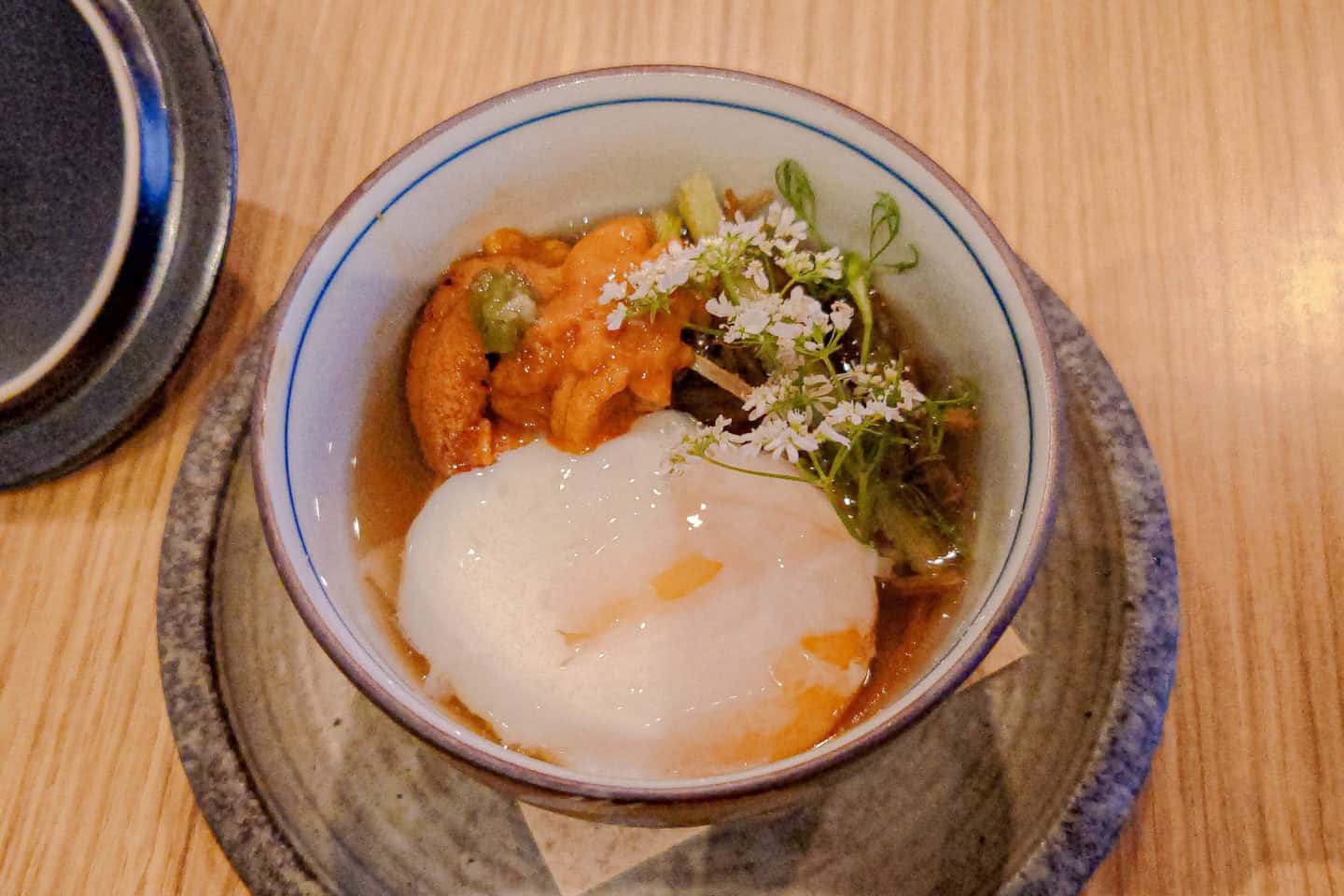
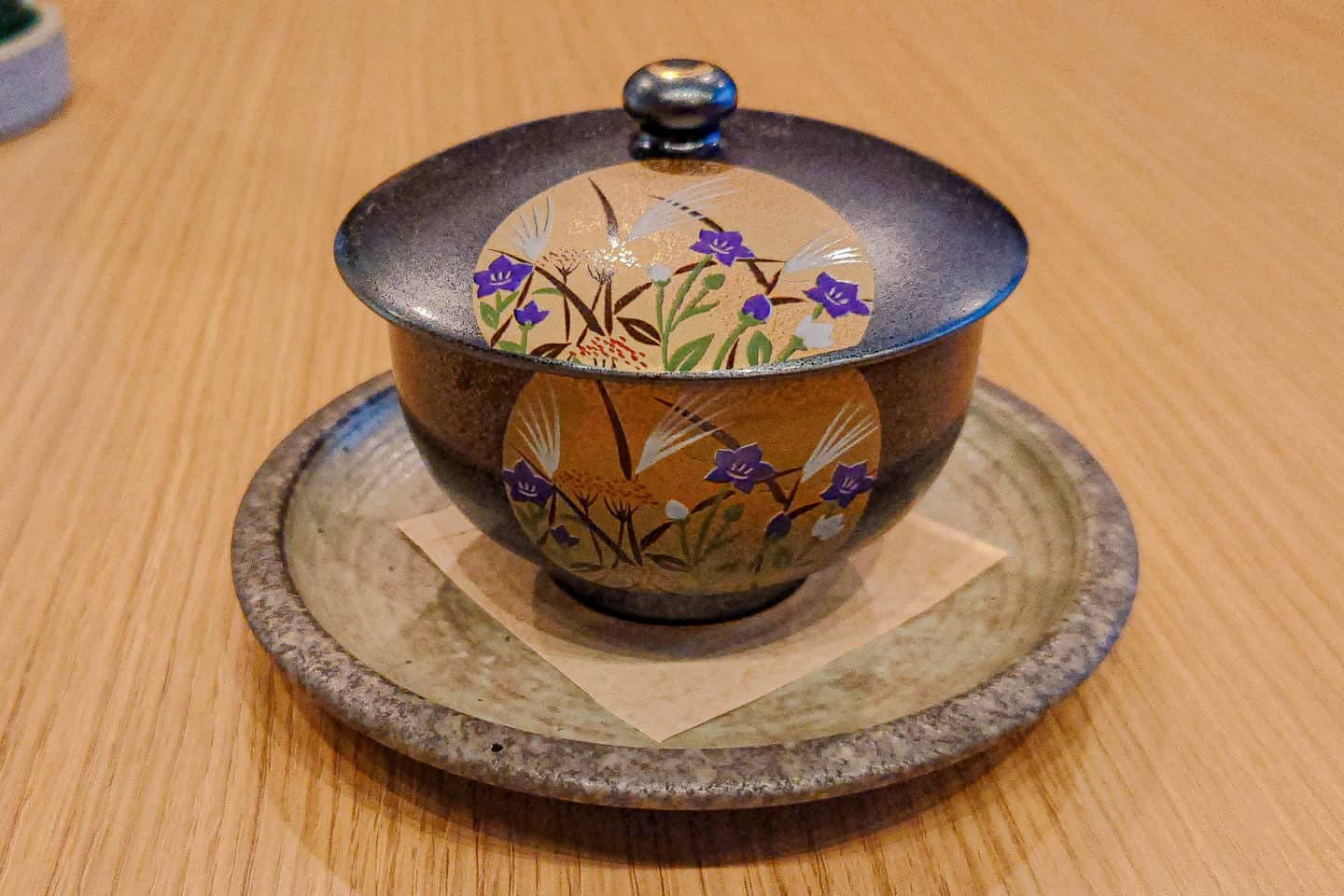
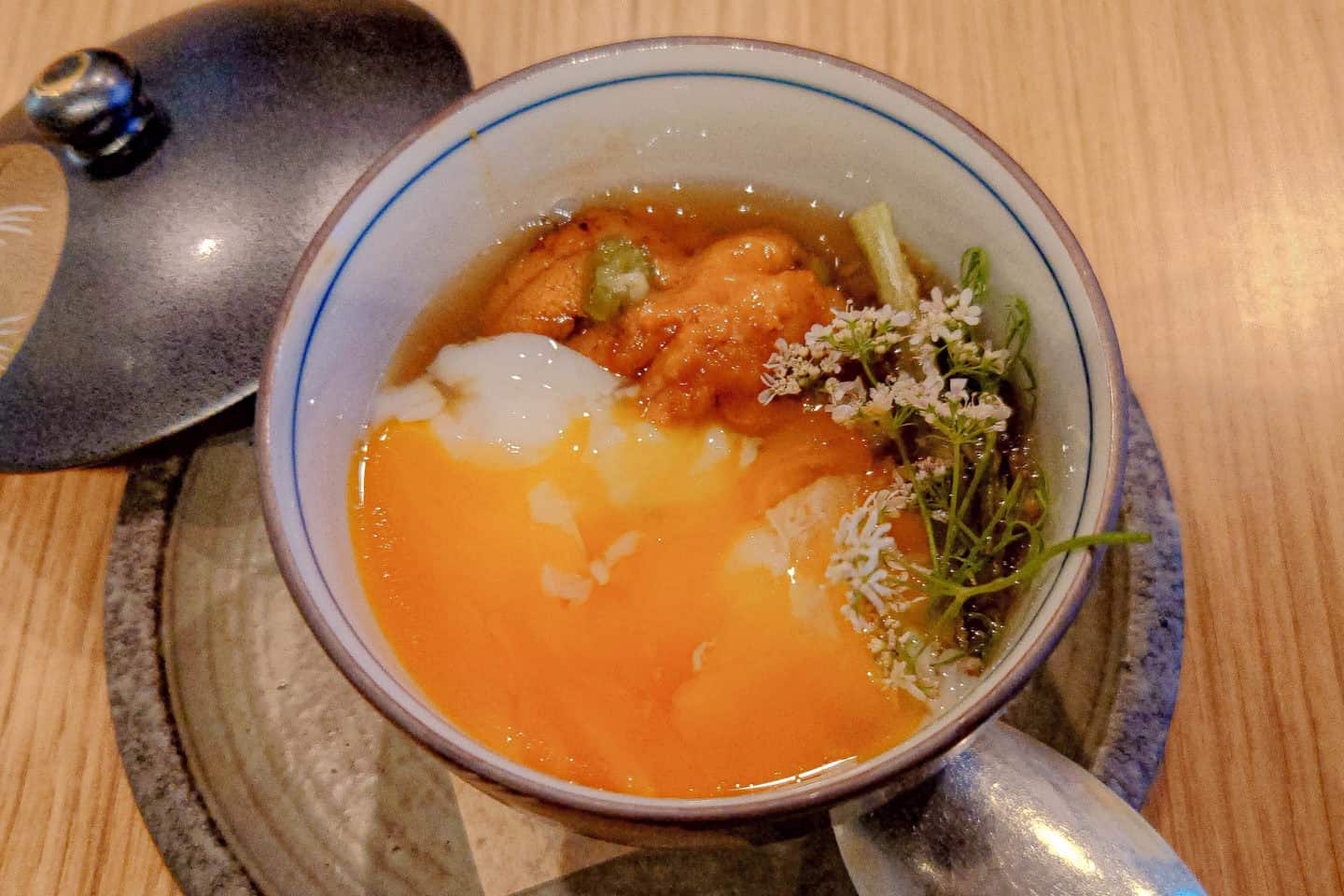
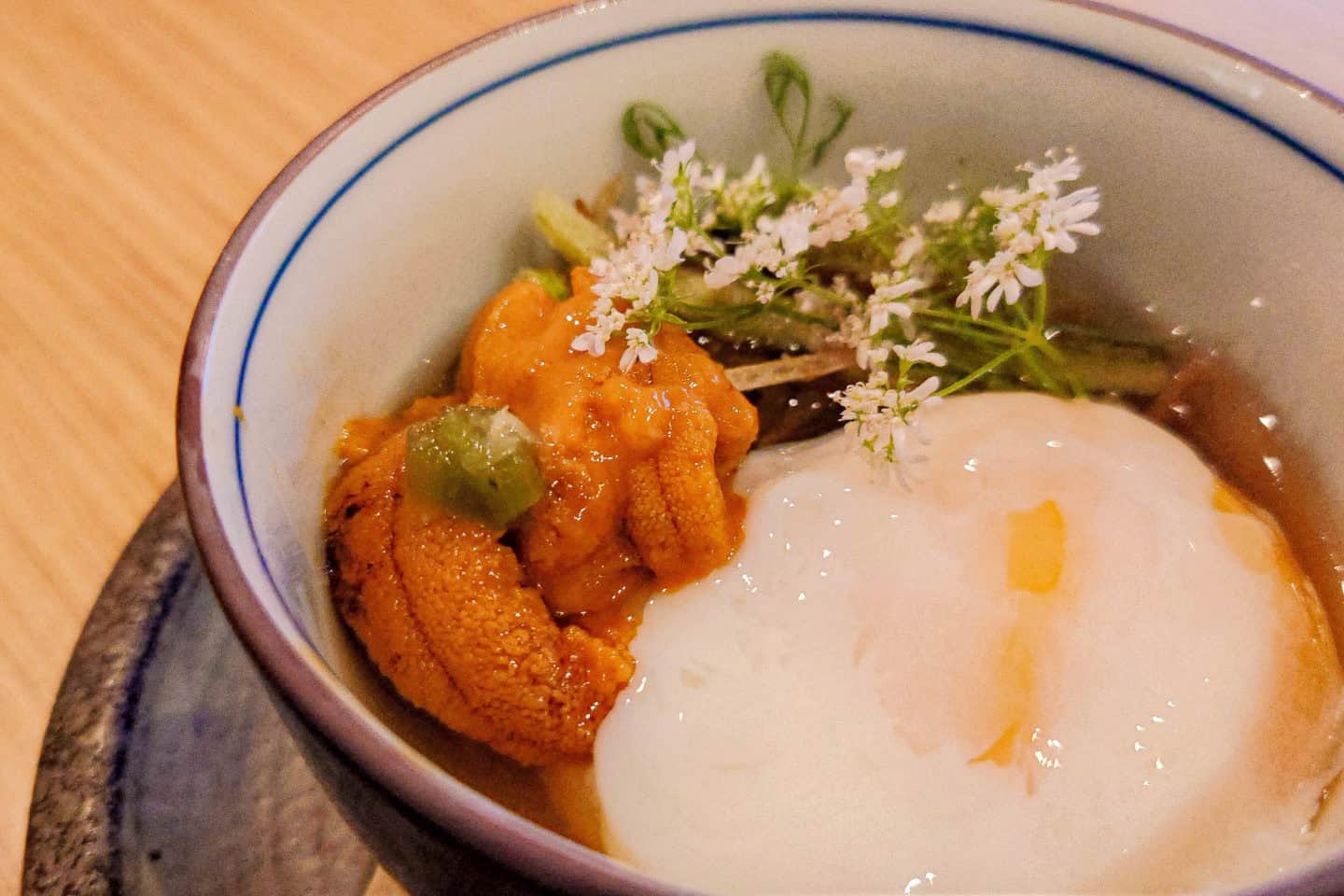
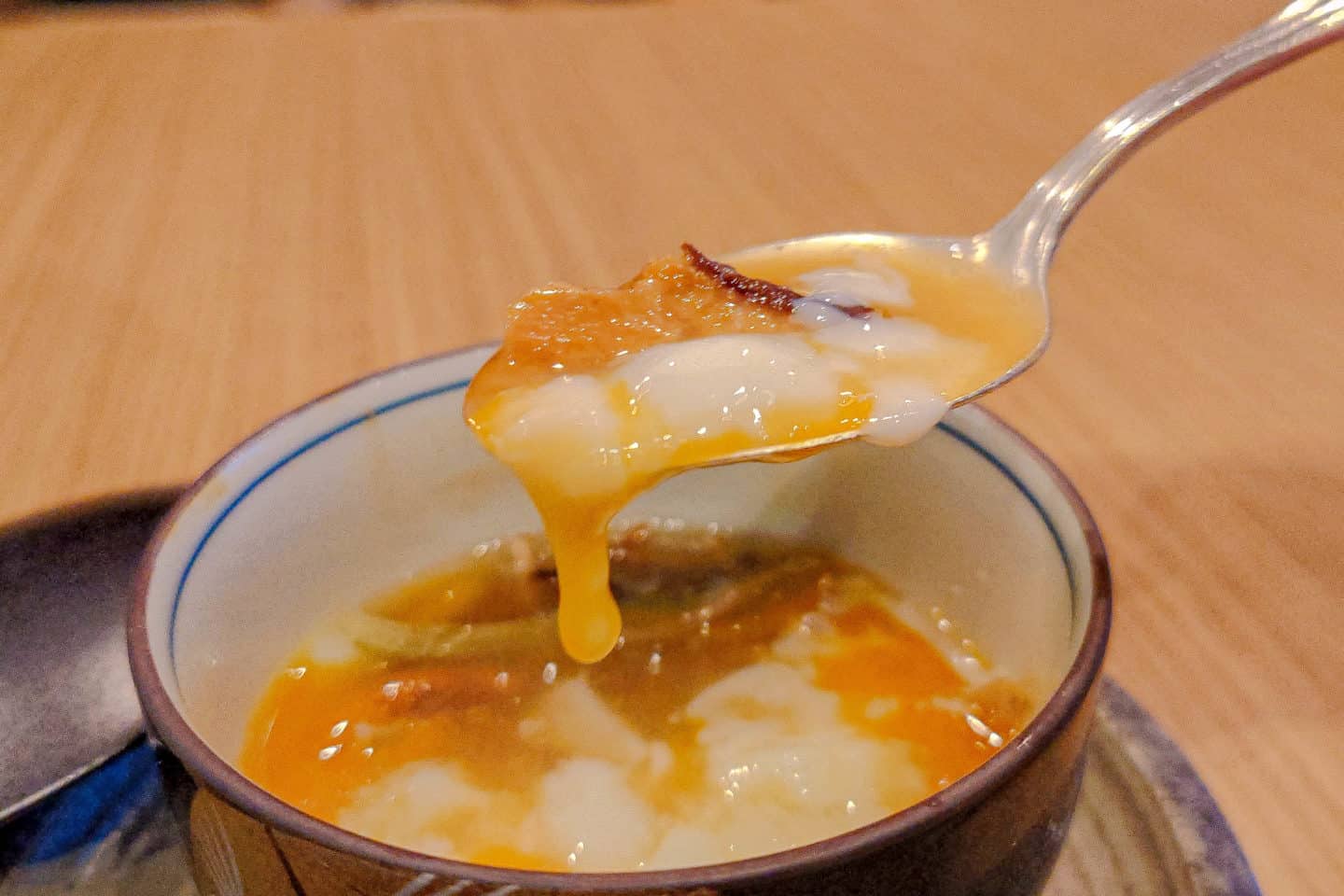
The menu started off strong with this amazing uni tamago. This was Hokkaido sea urchin and onsen egg (63°C) in a shoyu-dashi broth with fried leeks.
It was a very creative starter, inspired from Central Thailand. The use of creamy and gooey onsen egg instead of the typical silken ‘chawanmushi’ was brilliant, and paired well with the umami and sweetness of the shoyu-dashi broth. The sea urchin was decadent and creamy. The leeks were tiny crunches that added a nice contrast to the egg. Everything was delicious but we would have preferred it served warm, not cold.
It was a very creative starter, inspired from Central Thailand. The use of creamy and gooey onsen egg instead of the typical silken ‘chawanmushi’ was brilliant, and paired well with the umami and sweetness of the shoyu-dashi broth. The sea urchin was decadent and creamy. The leeks were tiny crunches that added a nice contrast to the egg. Everything was delicious but we would have preferred it served warm, not cold.
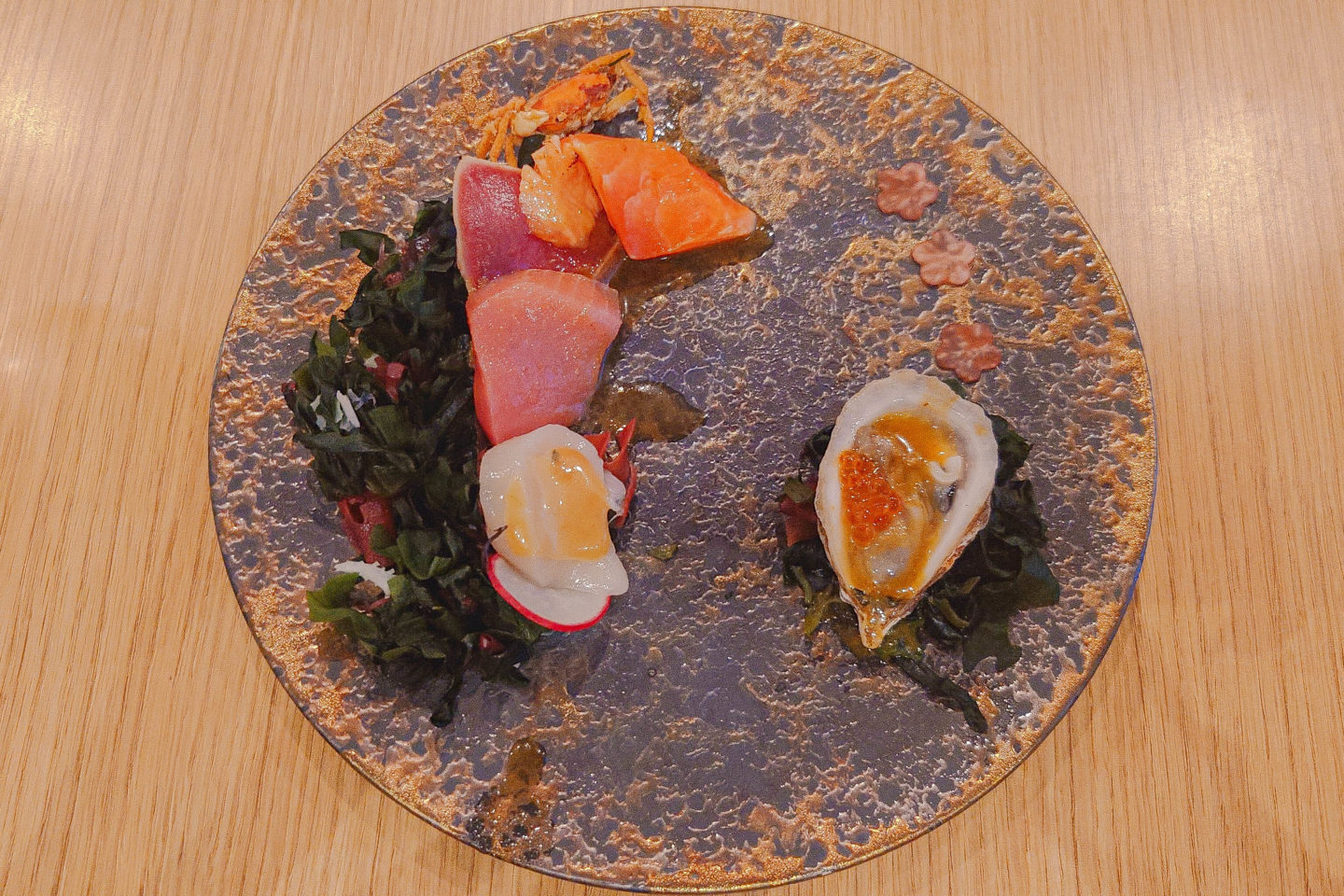
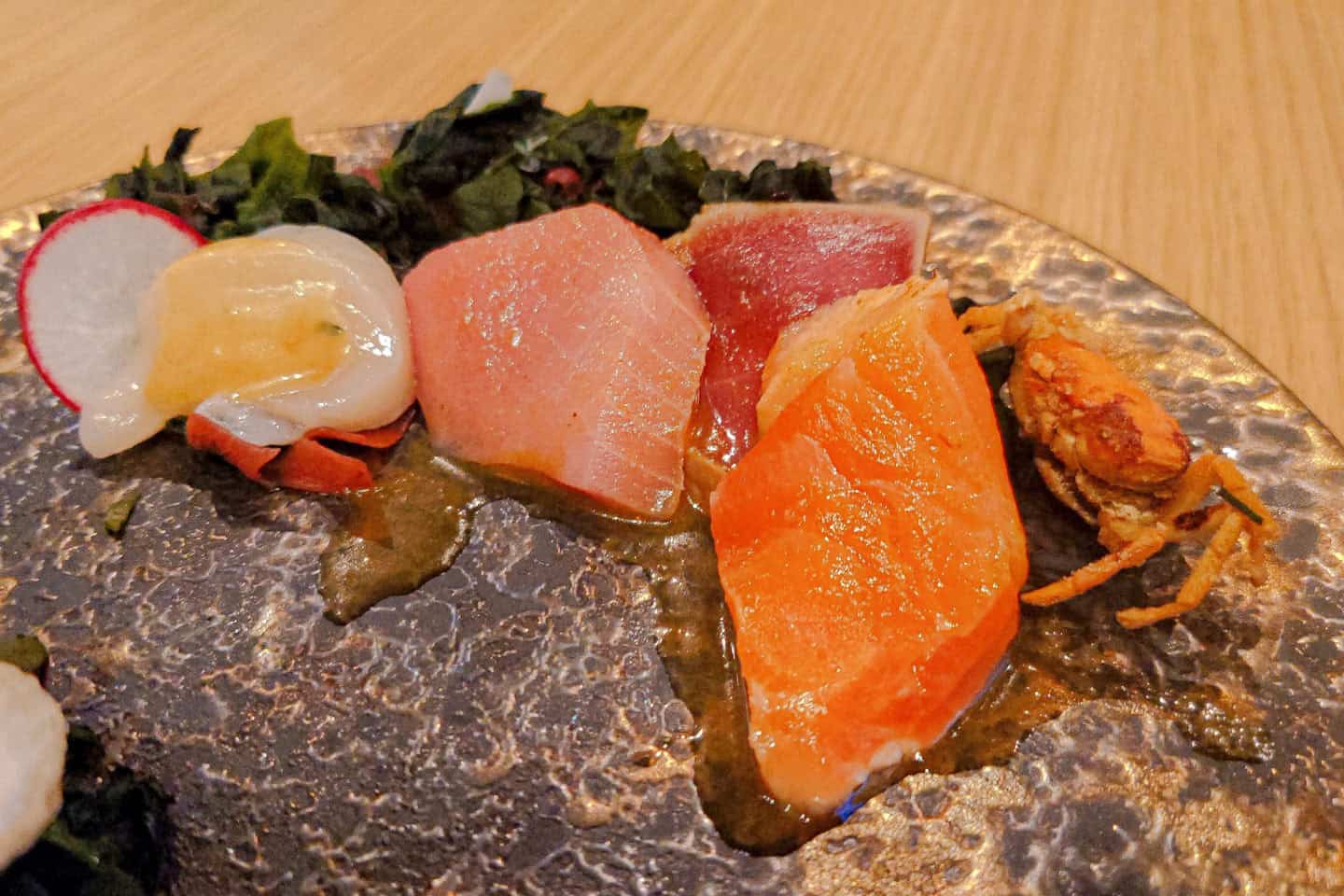
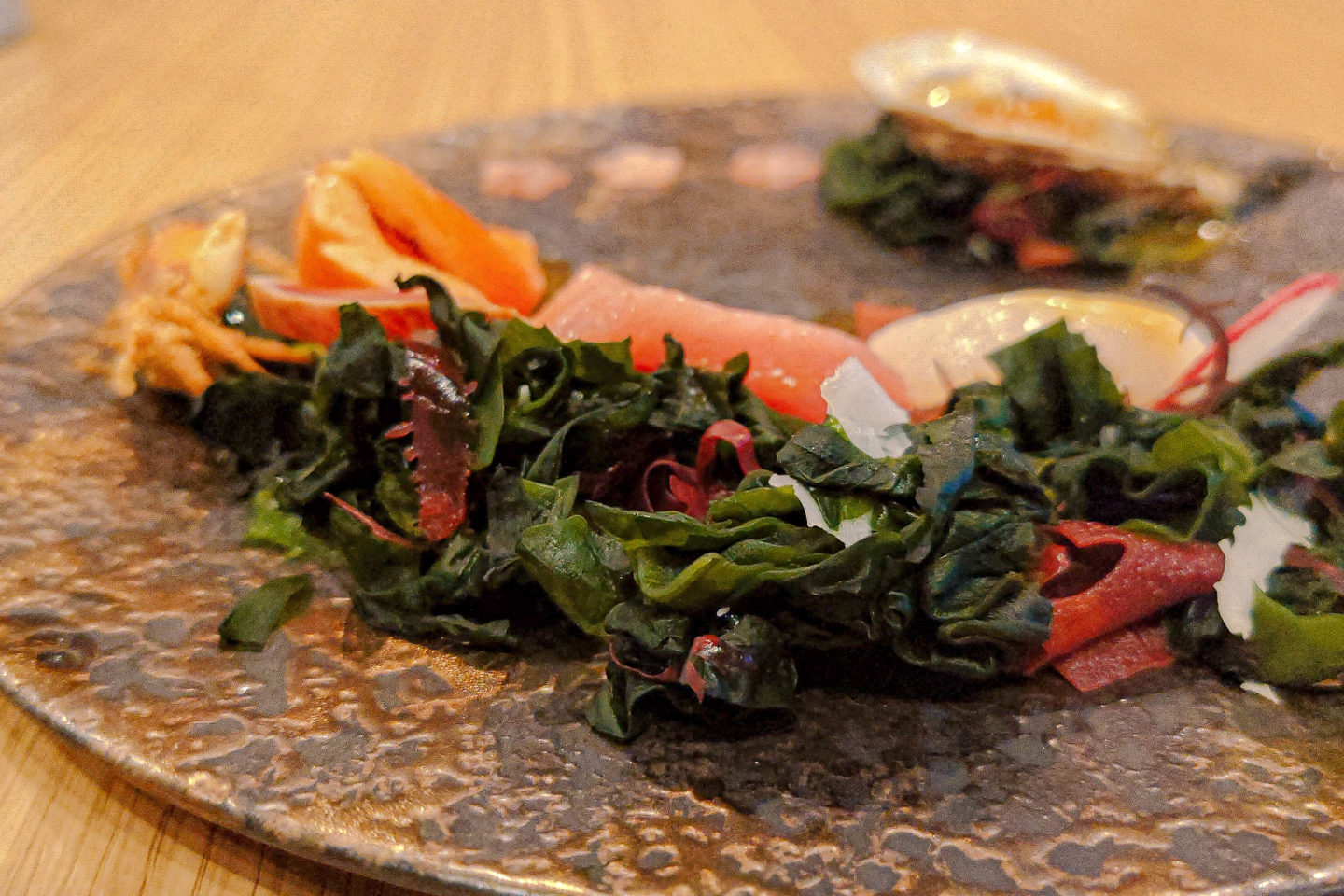
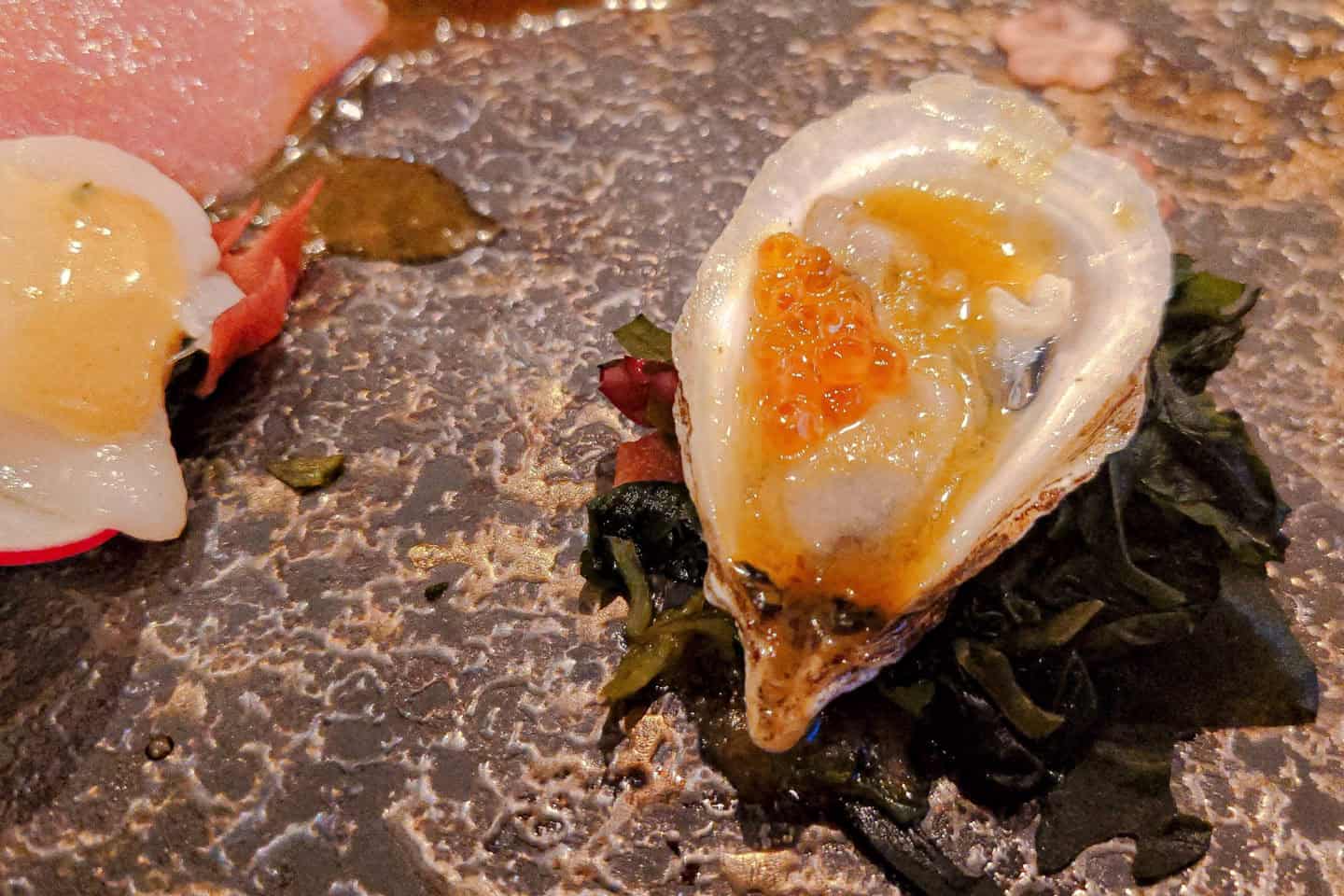
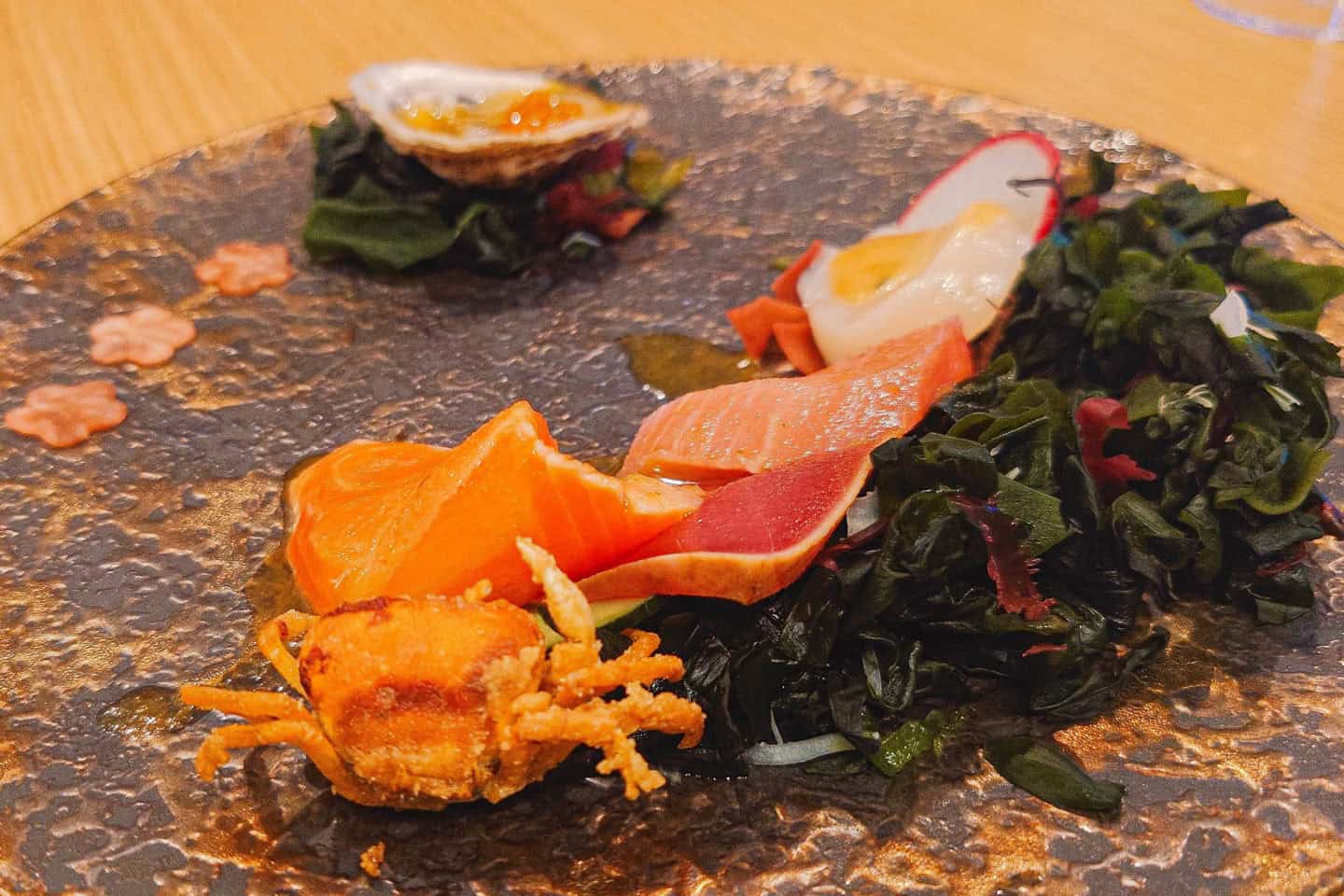
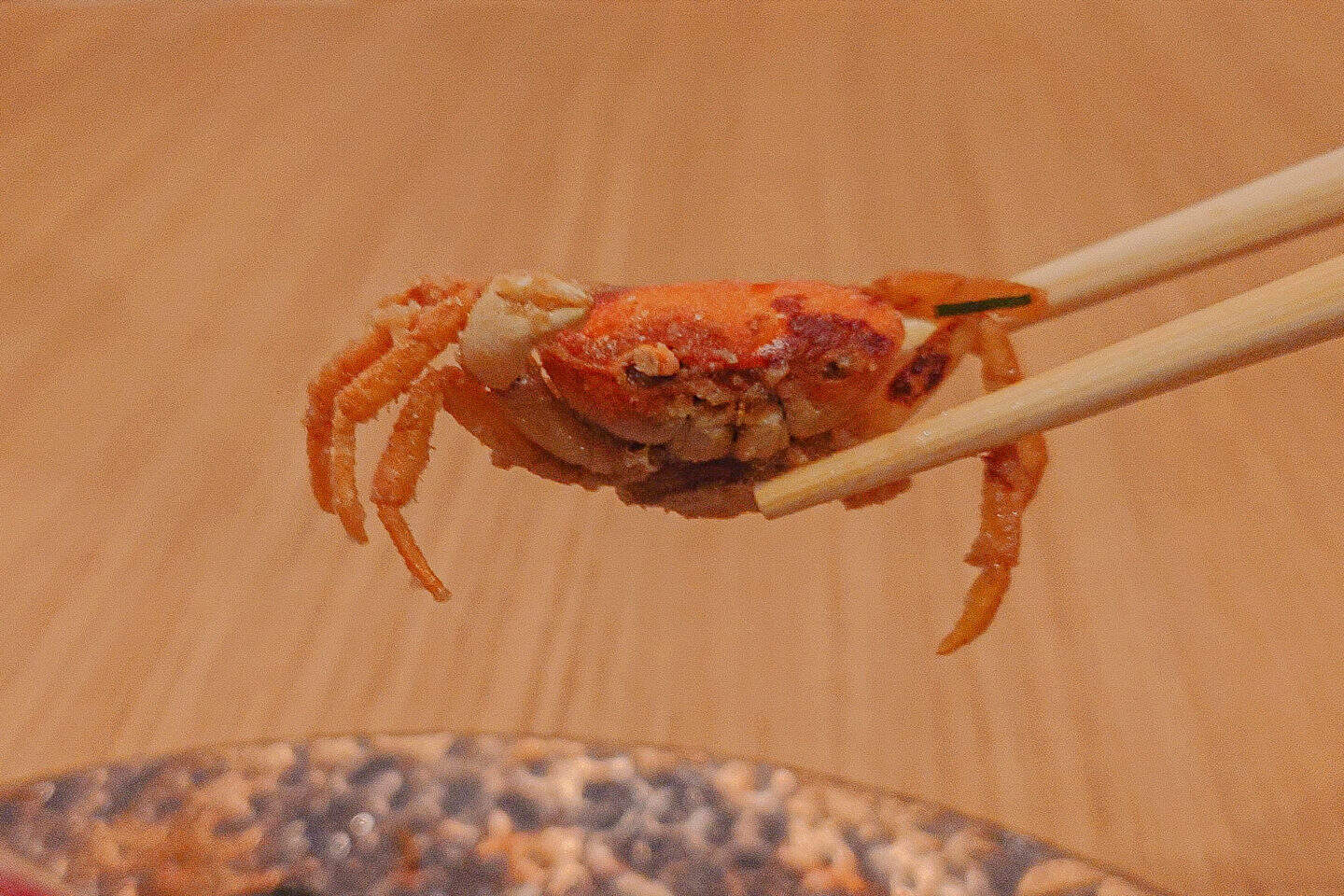
This sashimi plate had
beau soleil oyster, dry-aged ocean trout, dry-aged bluefin tuna, ikura, shima aji, soft shell crab, wakame seaweed, kaffir butter sauce, yuzu-seafood sauce, and wasabi.
This was a beautifully presented dish, with fresh seafood that had a straightforward flavour expectation. We really enjoyed the tiny soft shell crab. I devoured the non-salty kombu because I wanted value for money but it was like eating water so I should have skipped it.
The only pet peeve we have was the way the chef cut the sashimi. He used a straight motion instead of the Hira-zukuri technique. If they wanted to serve raw fish, they should have named the dish differently however by calling it “sashimi plate”, it was assumed that this was a Japanese fusion dish and therefore, expected to have Japanese elements. More on this below under Service.
This was a beautifully presented dish, with fresh seafood that had a straightforward flavour expectation. We really enjoyed the tiny soft shell crab. I devoured the non-salty kombu because I wanted value for money but it was like eating water so I should have skipped it.
The only pet peeve we have was the way the chef cut the sashimi. He used a straight motion instead of the Hira-zukuri technique. If they wanted to serve raw fish, they should have named the dish differently however by calling it “sashimi plate”, it was assumed that this was a Japanese fusion dish and therefore, expected to have Japanese elements. More on this below under Service.
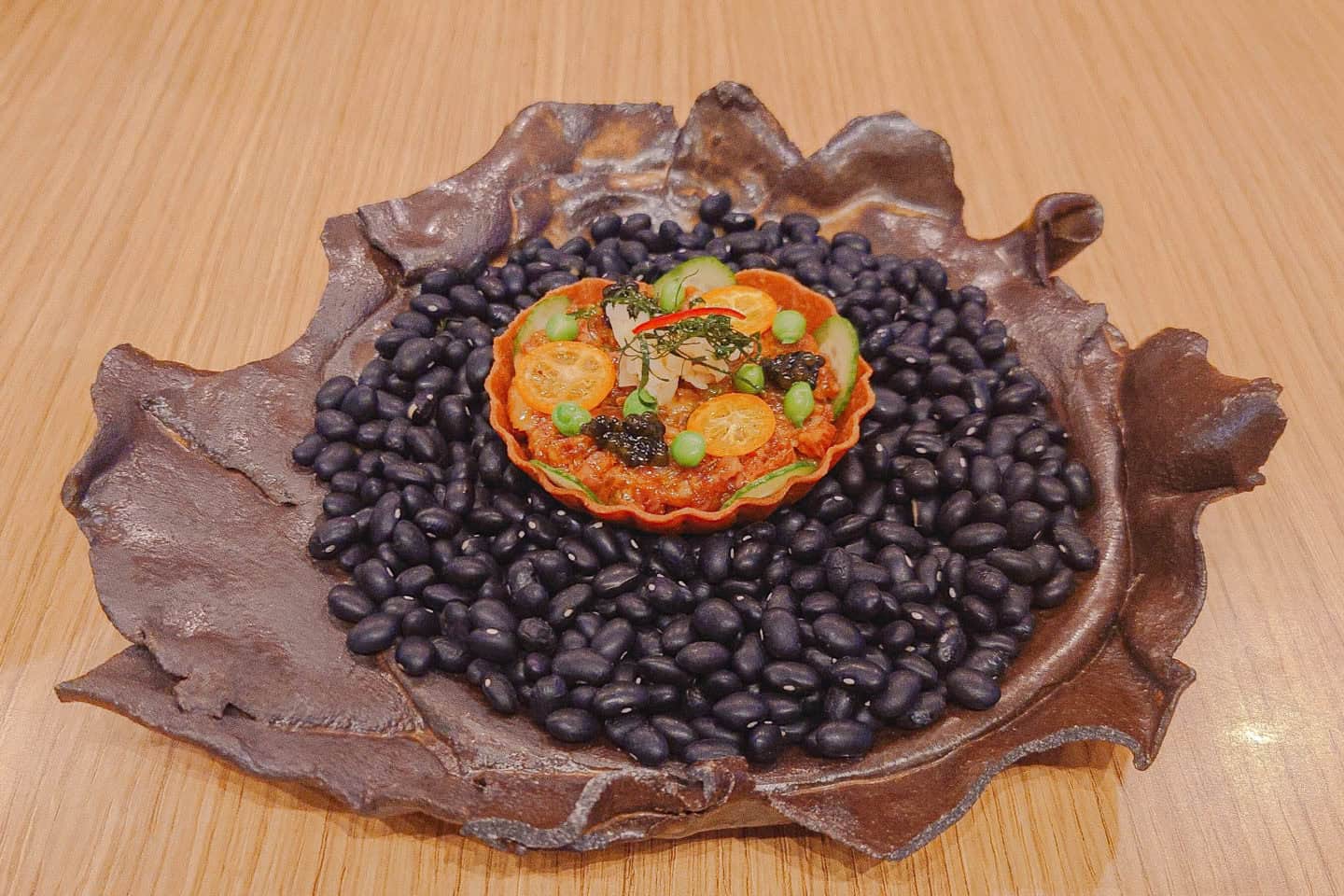
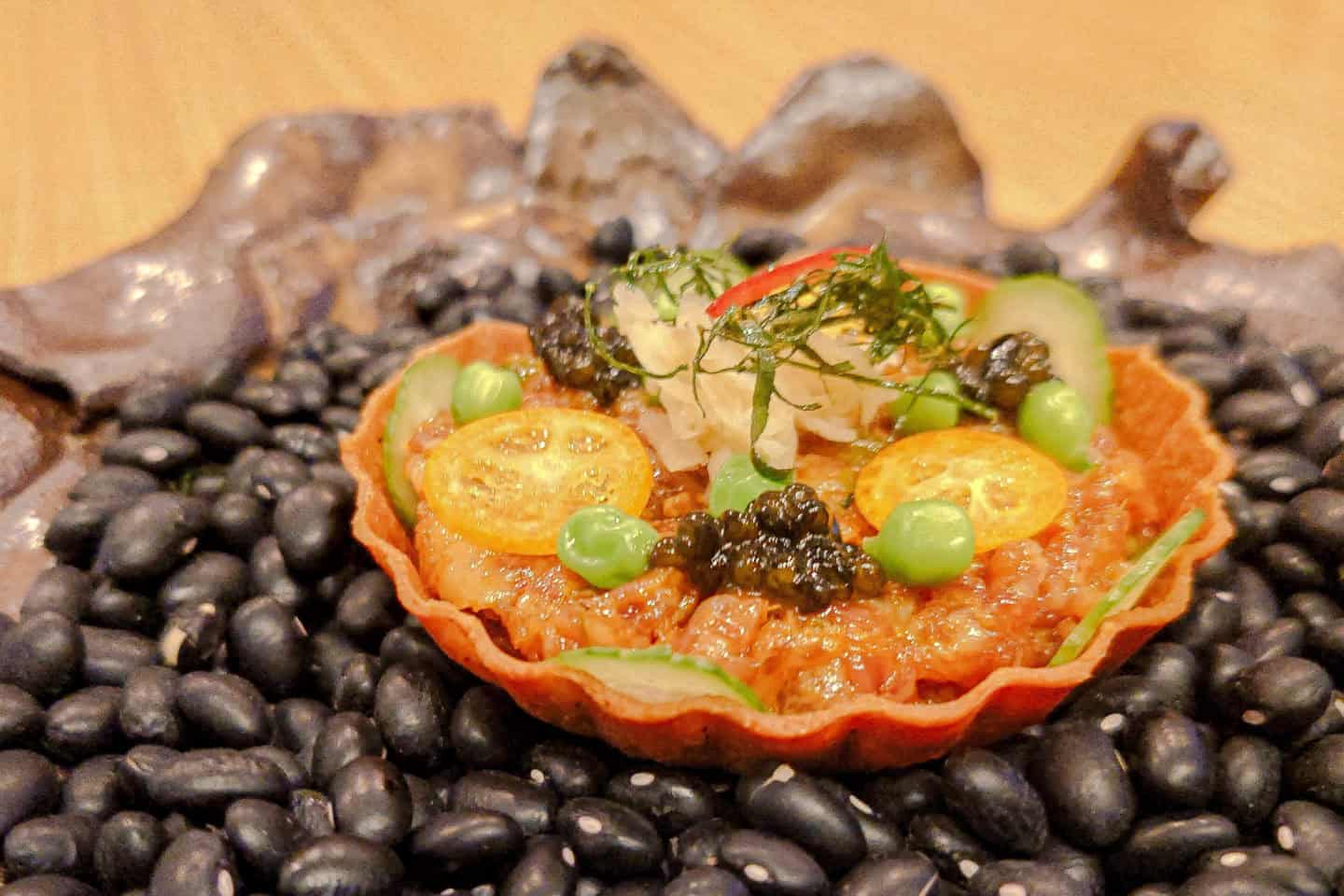
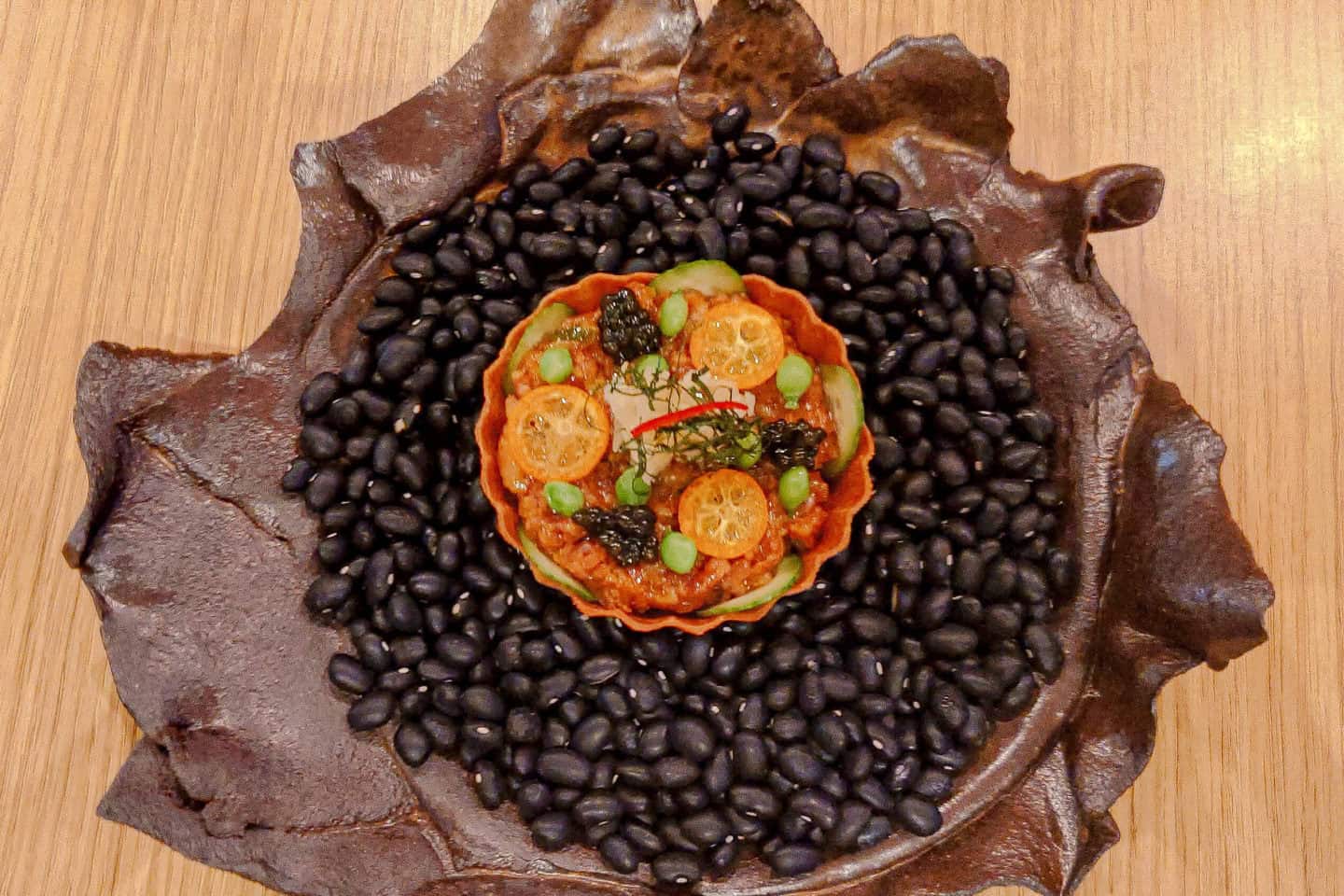
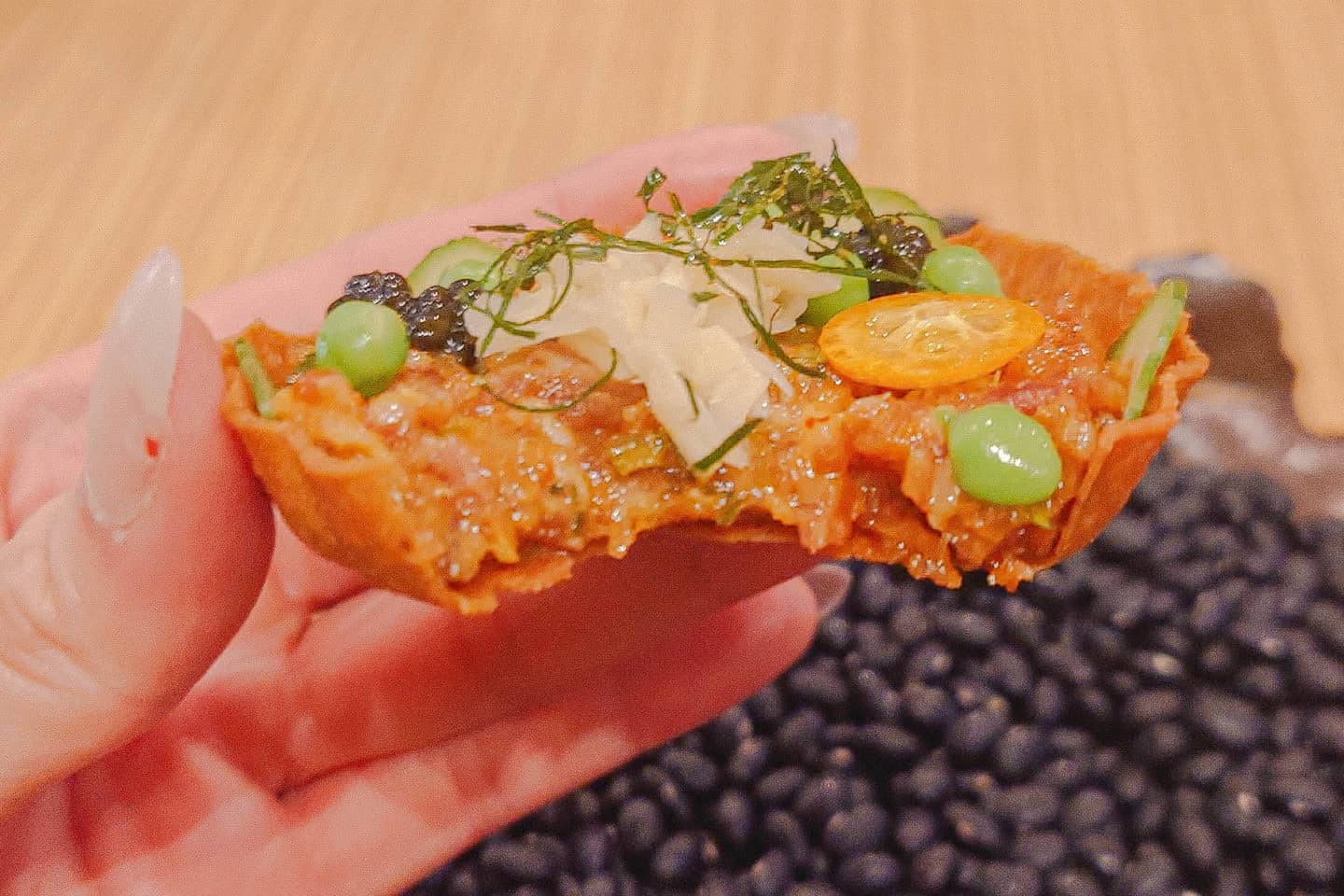
This tartare was A5 wagyu beef with Thai herb seasoning, kinkan (kumquat), caviar, sugar snap pea, magrood, and gari on an almond tart.
This was really creative. The chefs were trying to recreate traditional laab in a western way. The wagyu was seasoned with a lot of Thai spice (fish sauce, salt, garlic), which was delicious. Unfortunately the house-made tart was over cooked, giving it this unwanted charred taste that overpowered the filling. The bite ended up lacking luster.
This was really creative. The chefs were trying to recreate traditional laab in a western way. The wagyu was seasoned with a lot of Thai spice (fish sauce, salt, garlic), which was delicious. Unfortunately the house-made tart was over cooked, giving it this unwanted charred taste that overpowered the filling. The bite ended up lacking luster.
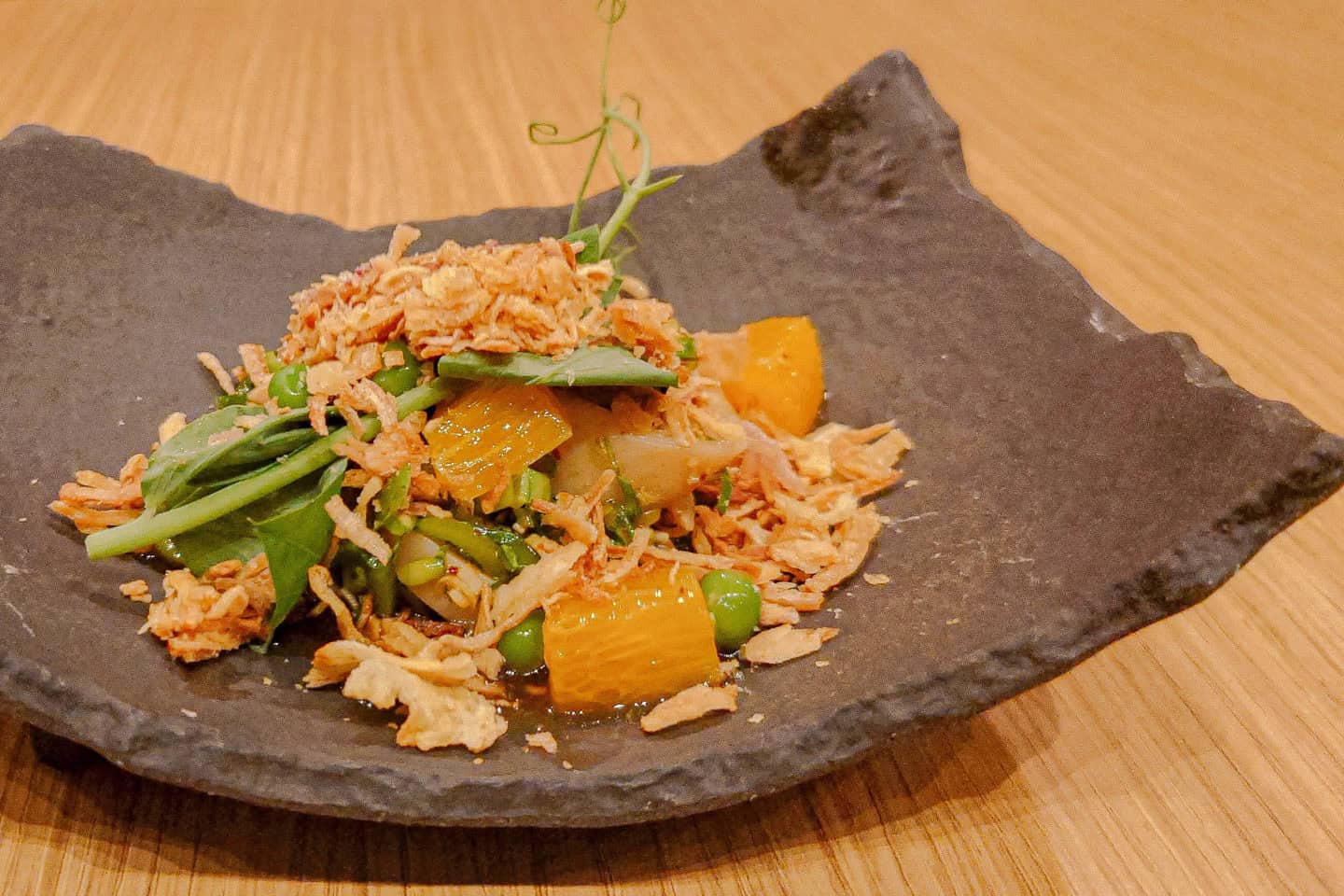
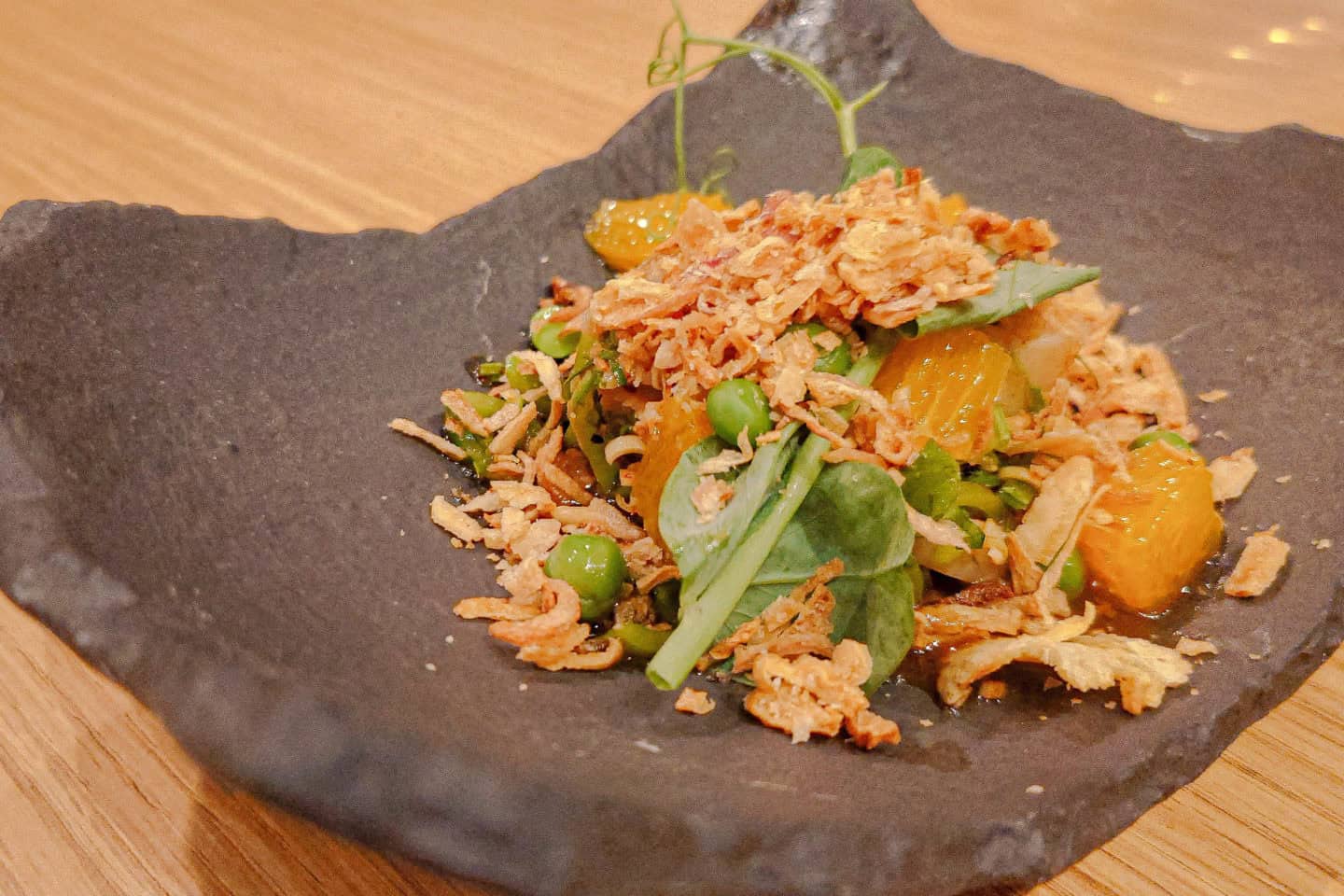
For our salad, we had live pacific razor clam, sugar snap pea, lemongrass, cilantro and fried shallot.
This reminded us of the Vietnamese mắm nêm; a pungent fermented anchovy-based sauce. The use of razor clams was unique – chosen because they wanted to change the menu. The clams were very tender and enjoyable to the palate. The chunks of orange were refreshing and cut through the sourness perfectly.
This reminded us of the Vietnamese mắm nêm; a pungent fermented anchovy-based sauce. The use of razor clams was unique – chosen because they wanted to change the menu. The clams were very tender and enjoyable to the palate. The chunks of orange were refreshing and cut through the sourness perfectly.
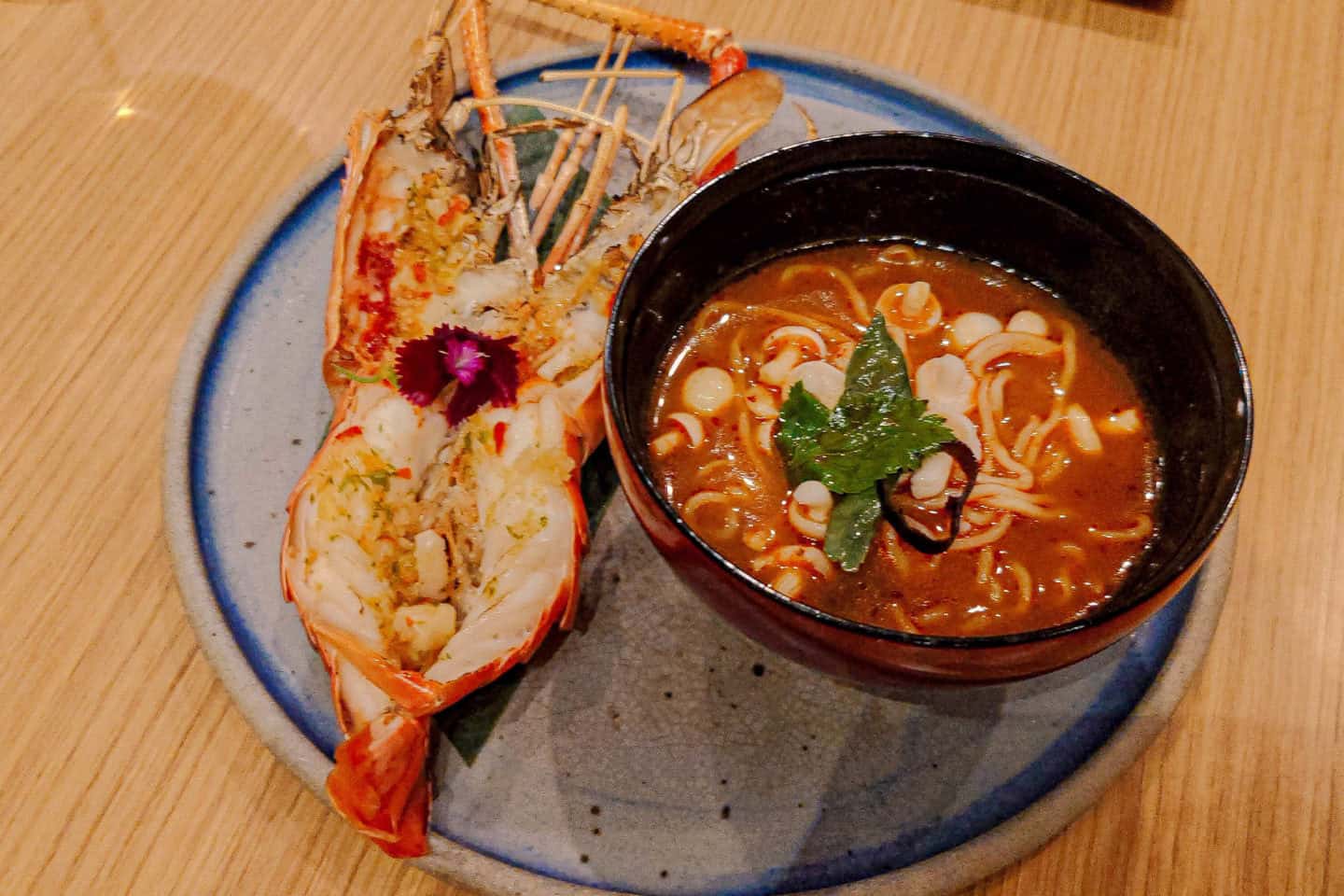
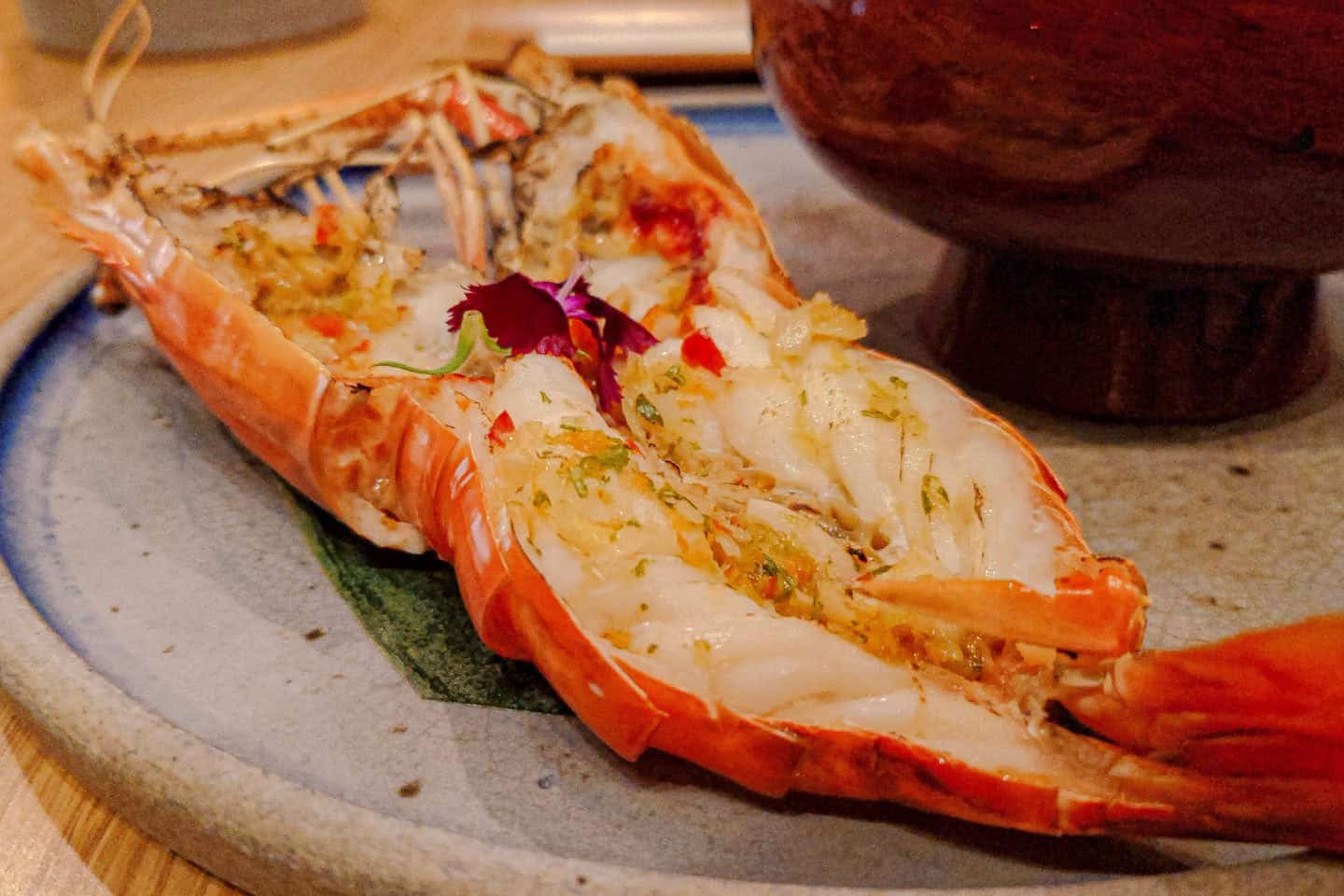
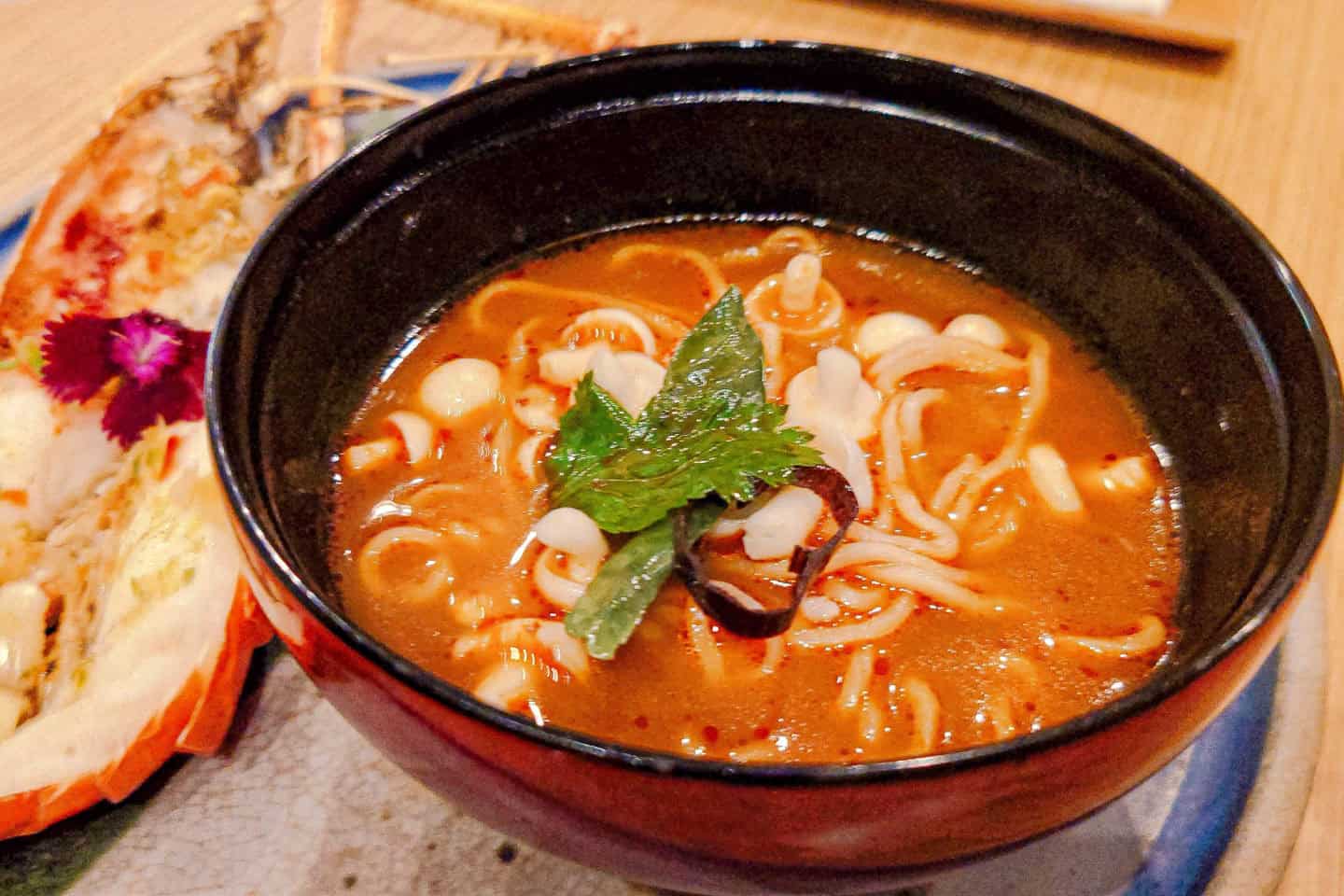
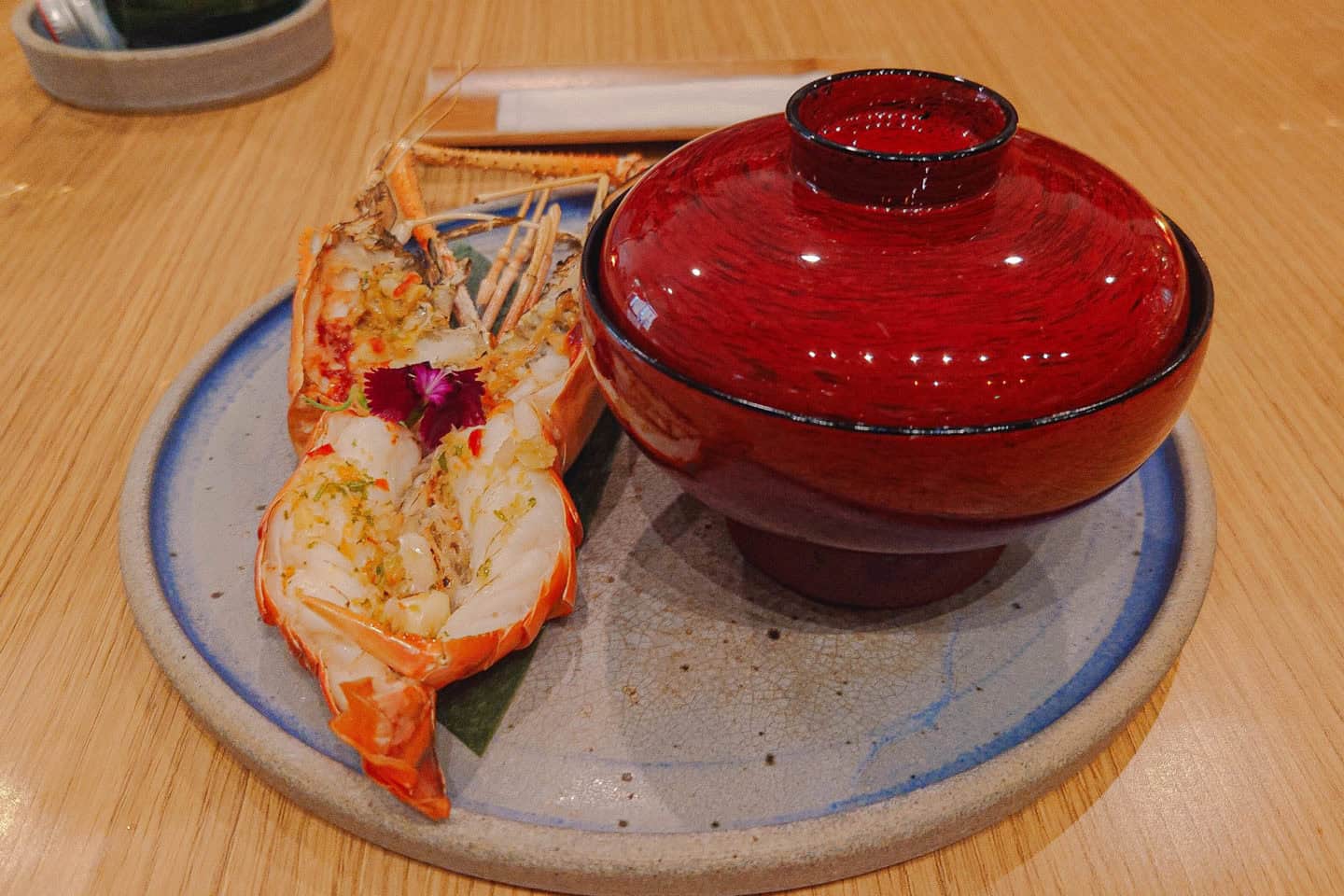
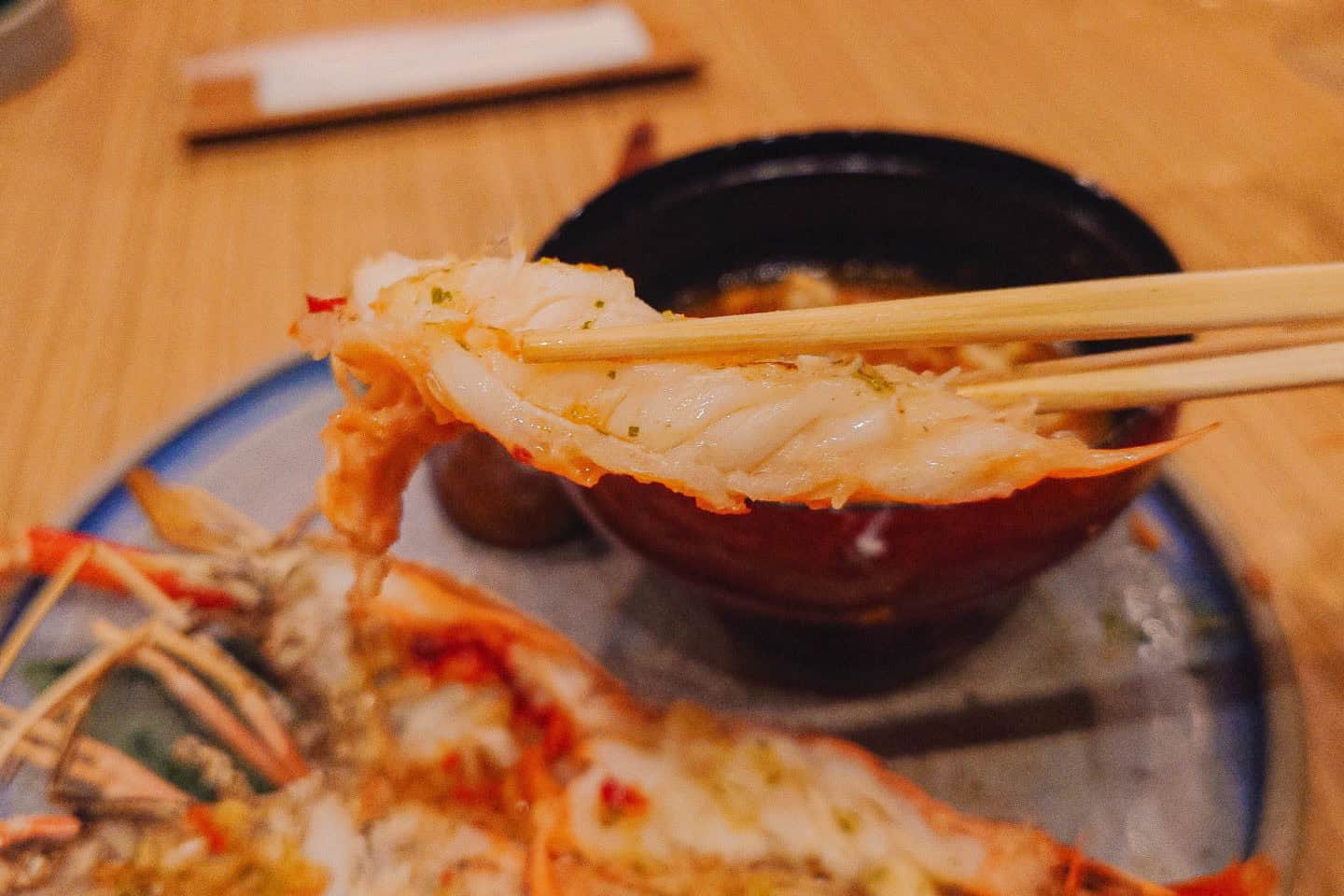
It’s not a Thai meal without some creamy tom yum. This was freshwater prawn, shimeji mushroom, and ramen in a tom yum based broth.
Our first impression was the fragrance of the dish. It had a aroma of seafood, spice and sourness. Upon tasting the broth, we were disappointed by the bitter undertones in the tom yum. It tasted like hepatopancreas, the liver and pancreas of the prawn when the prawn heads soak for too long in broth. As much as we tried to focus on the other flavours, the bitterness was a constant unwanted resonance in every bite.
Other than that, the prawn itself was succulent and sweet; and the ramen noodles were enjoyable to eat. They said this dish was inspired by Central Thailand.
Our first impression was the fragrance of the dish. It had a aroma of seafood, spice and sourness. Upon tasting the broth, we were disappointed by the bitter undertones in the tom yum. It tasted like hepatopancreas, the liver and pancreas of the prawn when the prawn heads soak for too long in broth. As much as we tried to focus on the other flavours, the bitterness was a constant unwanted resonance in every bite.
Other than that, the prawn itself was succulent and sweet; and the ramen noodles were enjoyable to eat. They said this dish was inspired by Central Thailand.
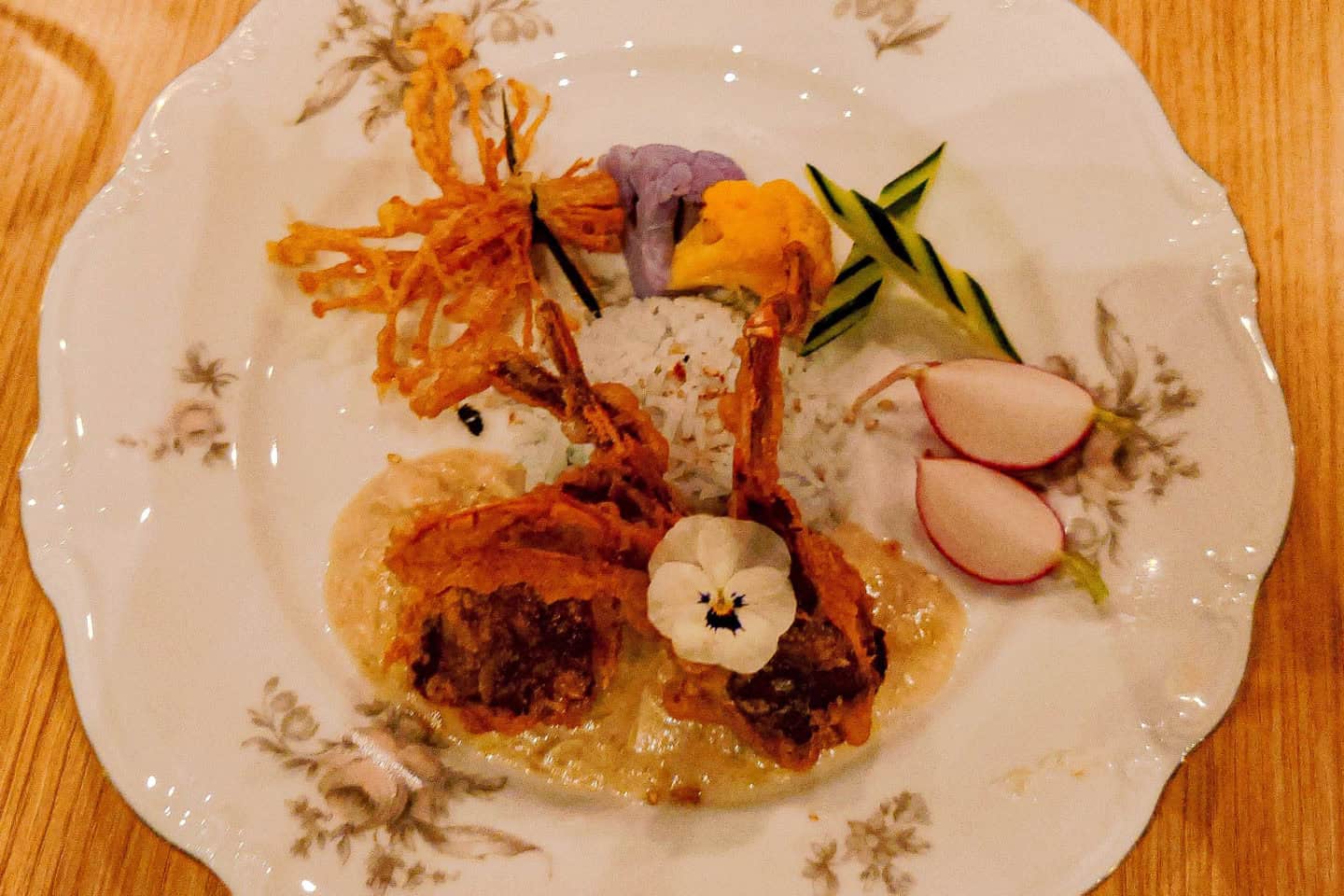
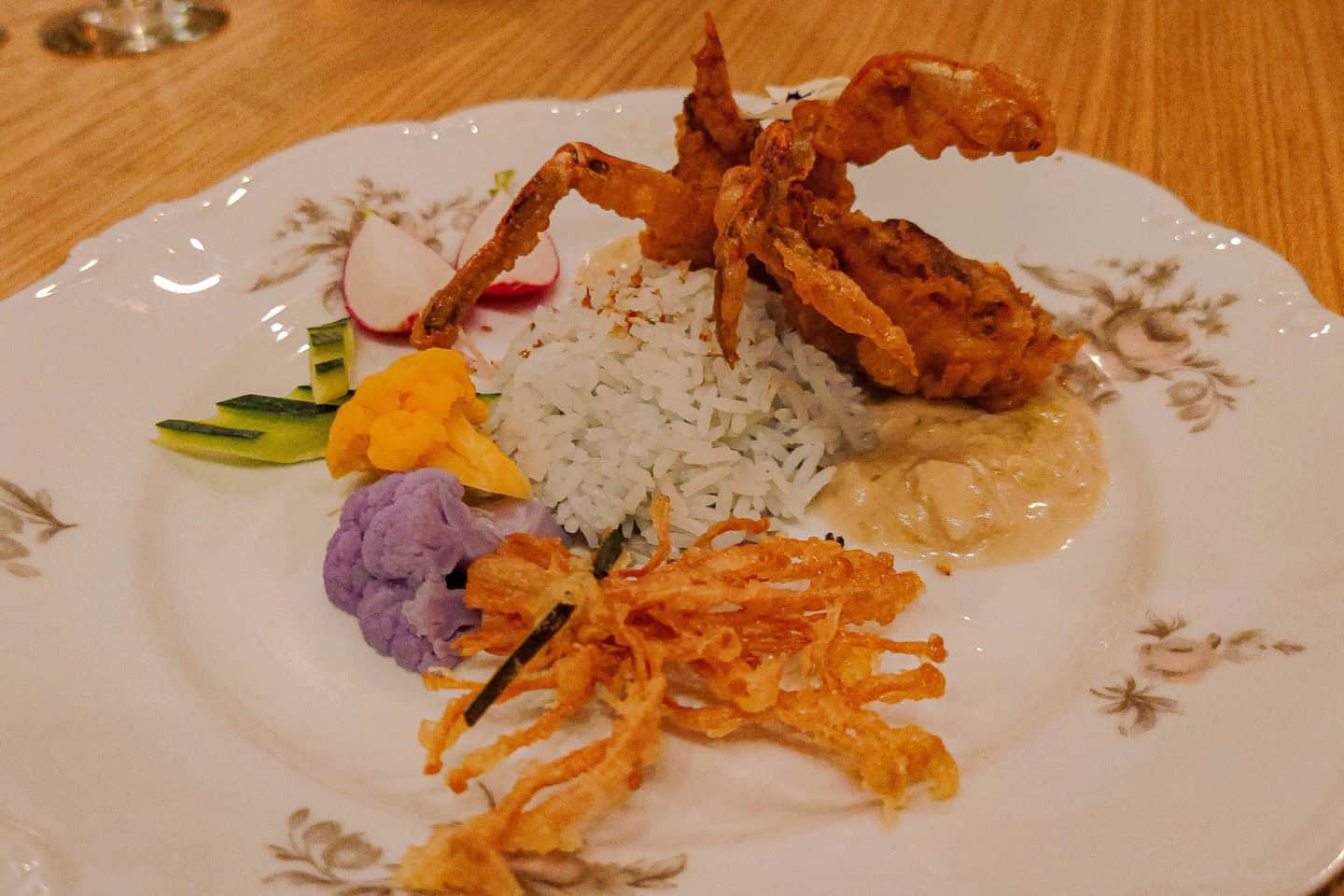
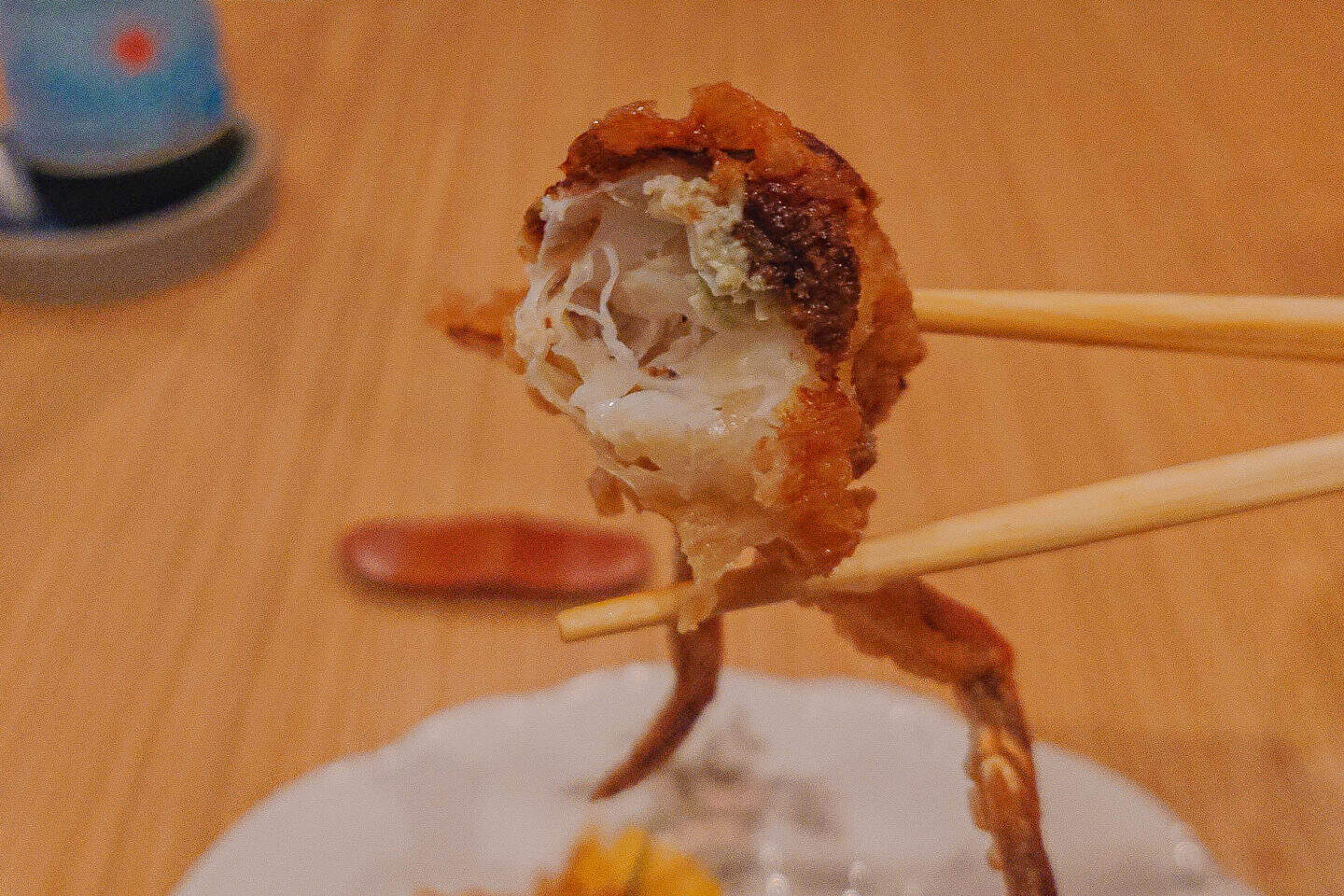
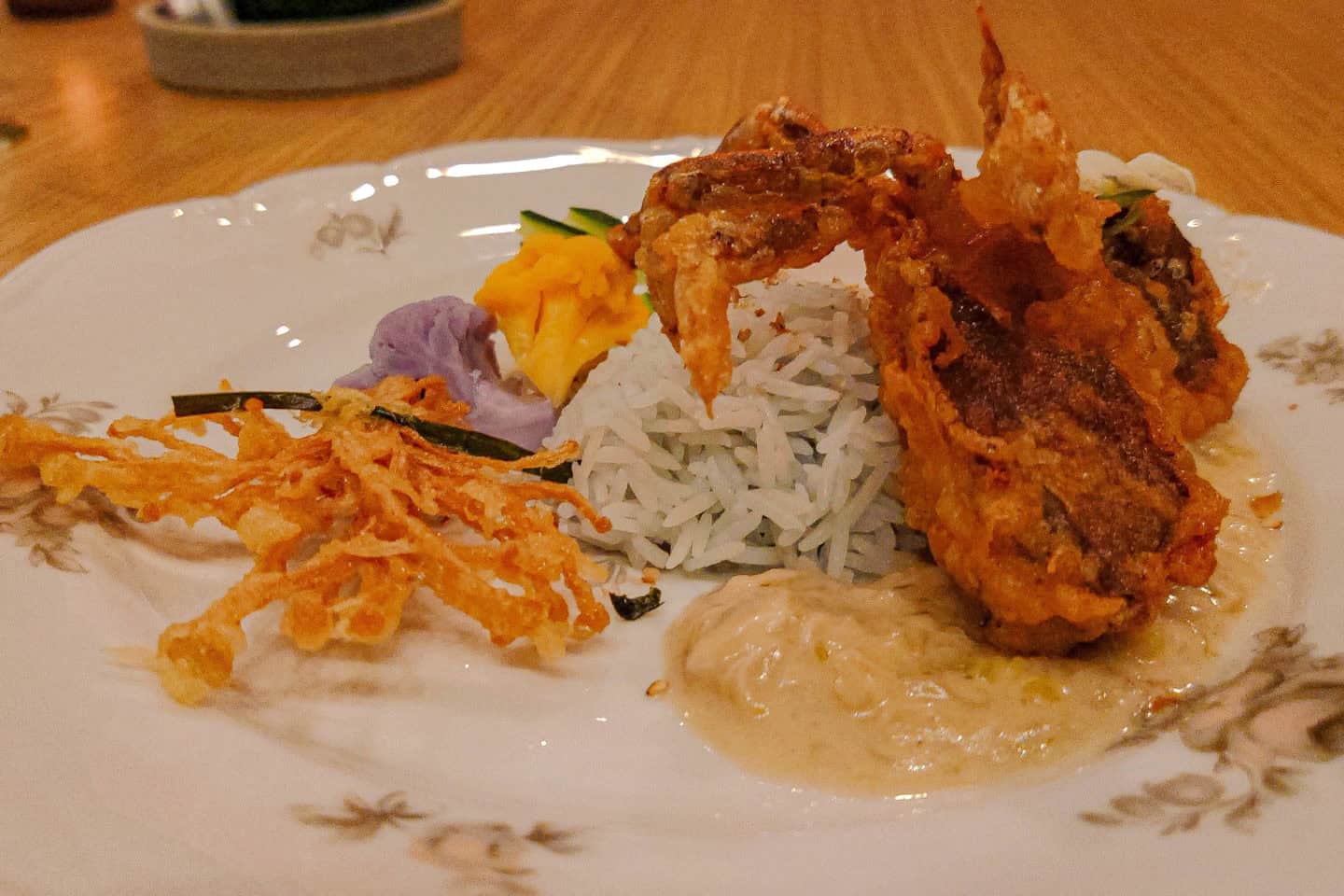
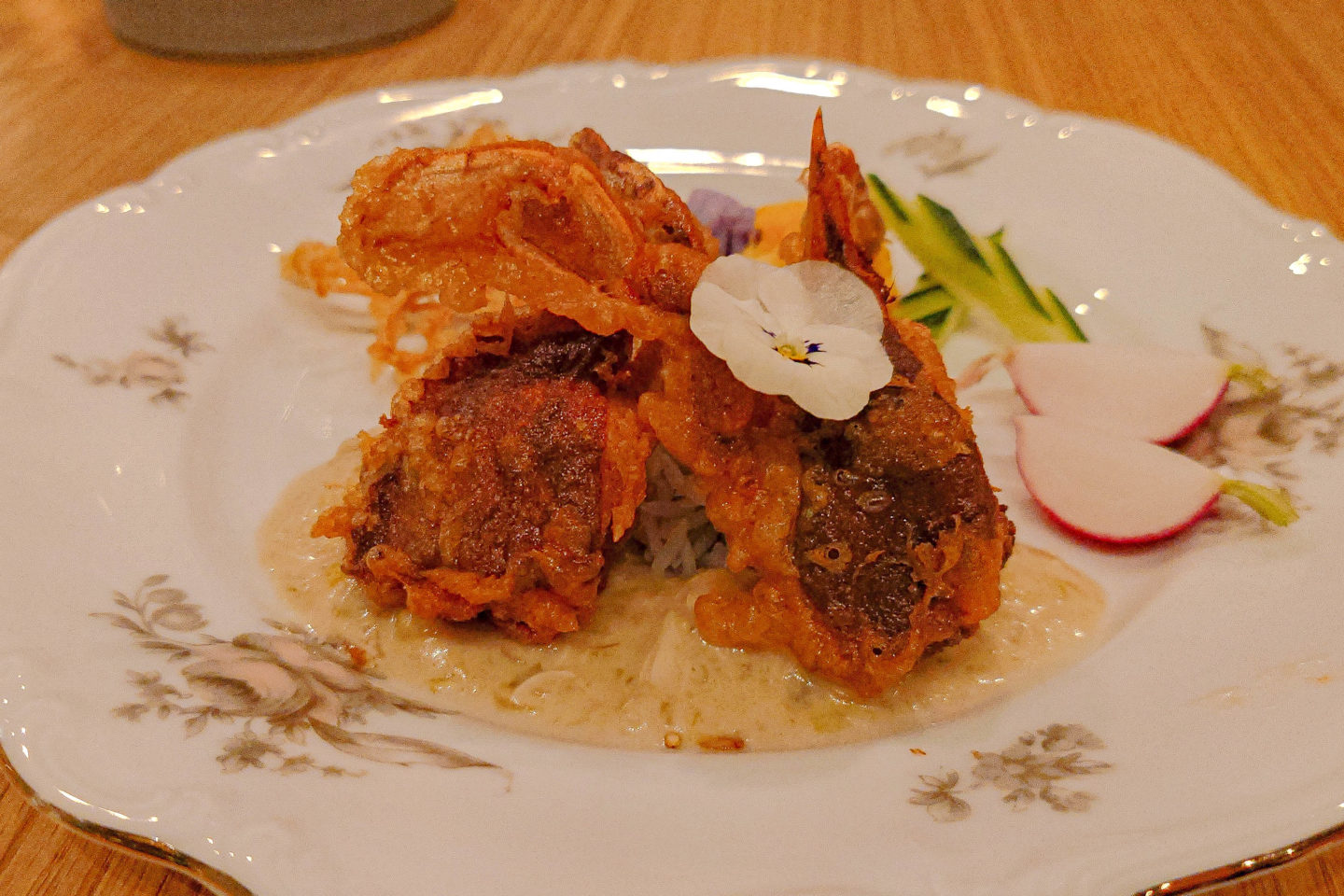
This was another Central Thailand inspired dish: live dungeness crab fried rice with Chef Nan’s egg, crab miso, and thai seafood sauce. It was what we envisioned for the words modern Thai.
The dish was a little all over the place but taste was okay. There was a subtle sweetness in the coconut rice, the umami in the fluffy crab meat and its soft shell, the crispy savouriness of the fried enoki, and the richness of the Massaman curry. The curry had a light viscosity mouthfeel.
The dish was a little all over the place but taste was okay. There was a subtle sweetness in the coconut rice, the umami in the fluffy crab meat and its soft shell, the crispy savouriness of the fried enoki, and the richness of the Massaman curry. The curry had a light viscosity mouthfeel.
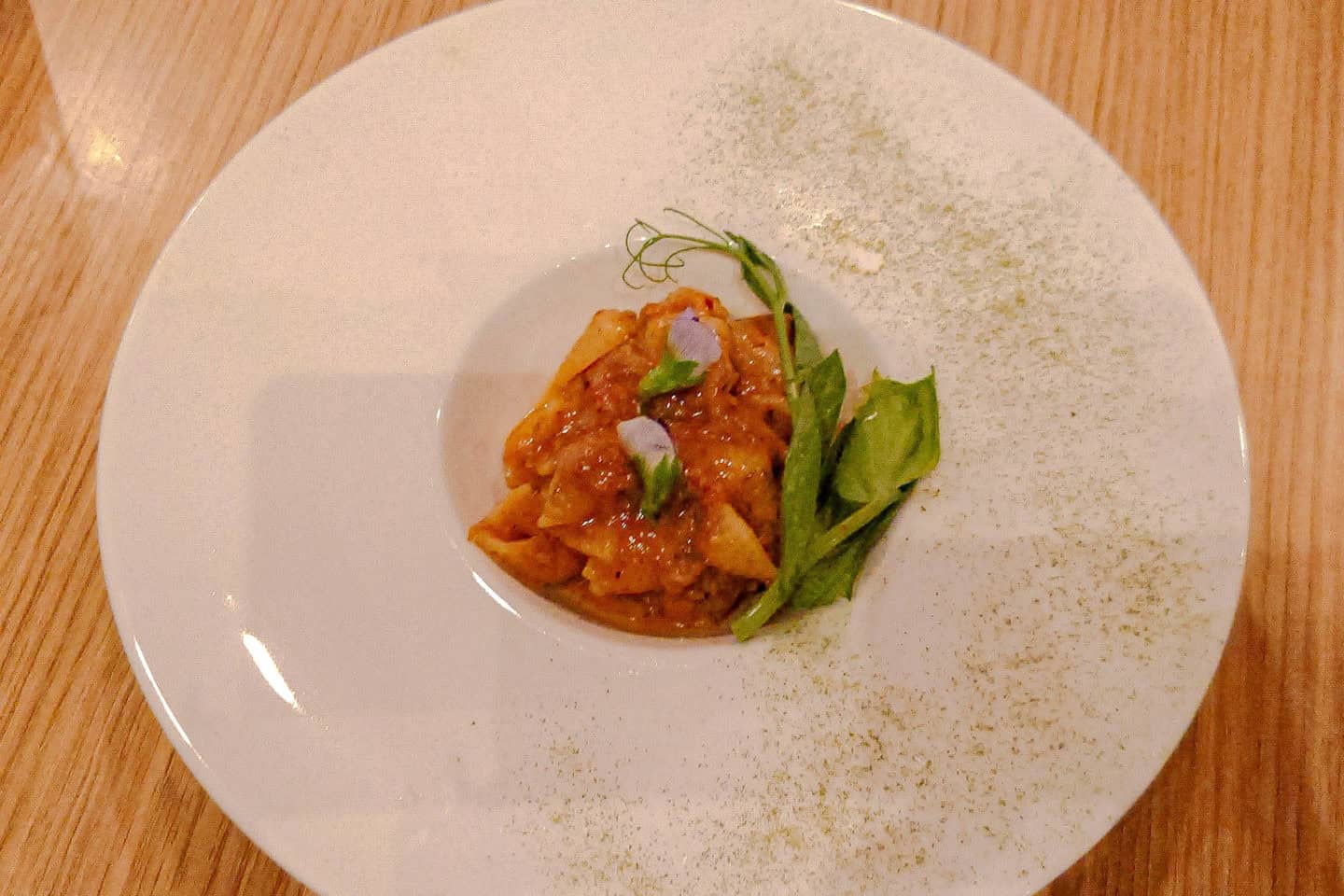
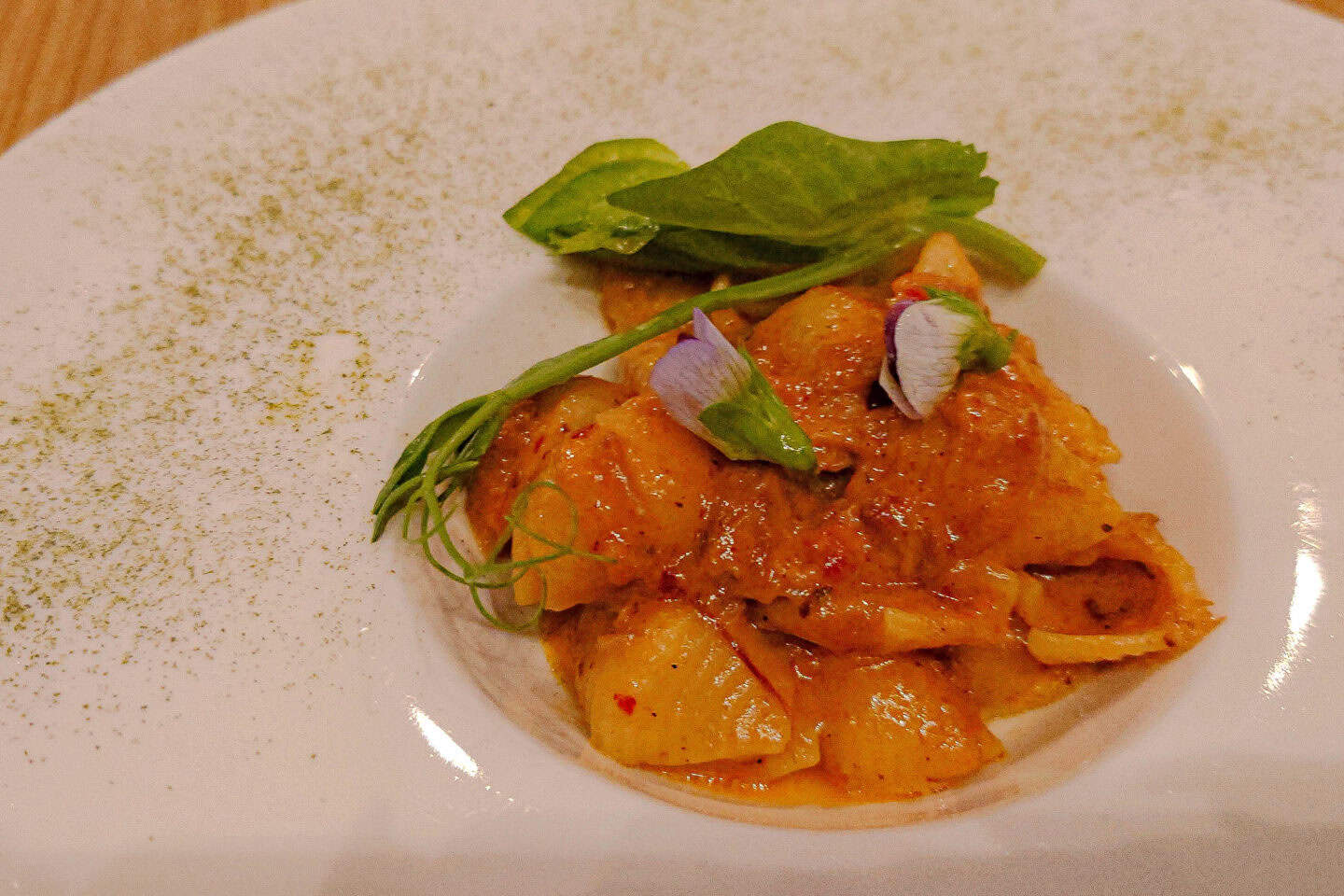
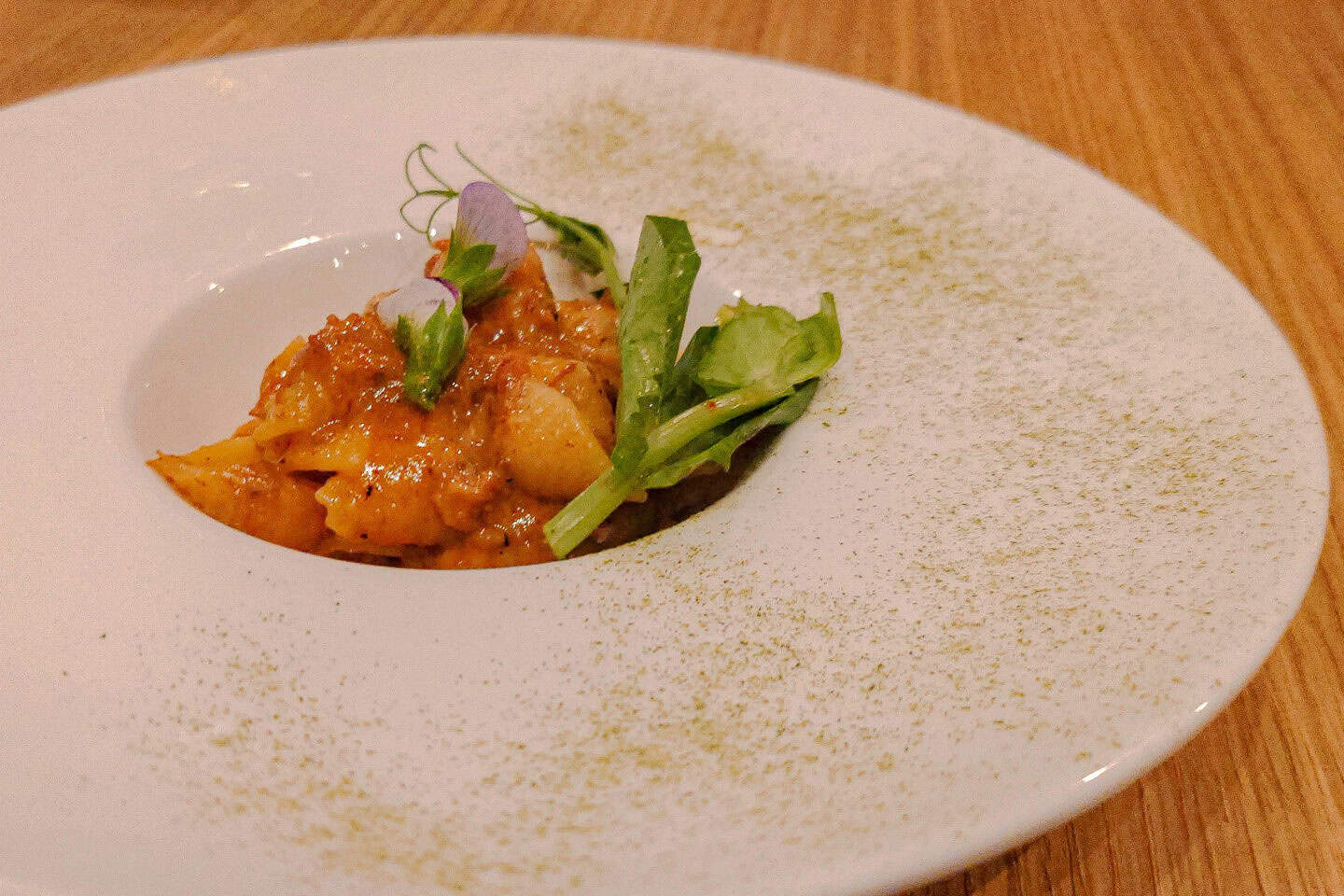
This was our last main: panang bolognese, a unique blend of Italian and Thai with duroc pork back ribs and conchiglie.
The pasta was cooked al dente. The sauce was thick and creamy, with a strong flavourful punch of massaman. It was too salty. The dish started off enjoyable but quickly became too heavy to finish (carbs and curry wombo combo).
The pasta was cooked al dente. The sauce was thick and creamy, with a strong flavourful punch of massaman. It was too salty. The dish started off enjoyable but quickly became too heavy to finish (carbs and curry wombo combo).
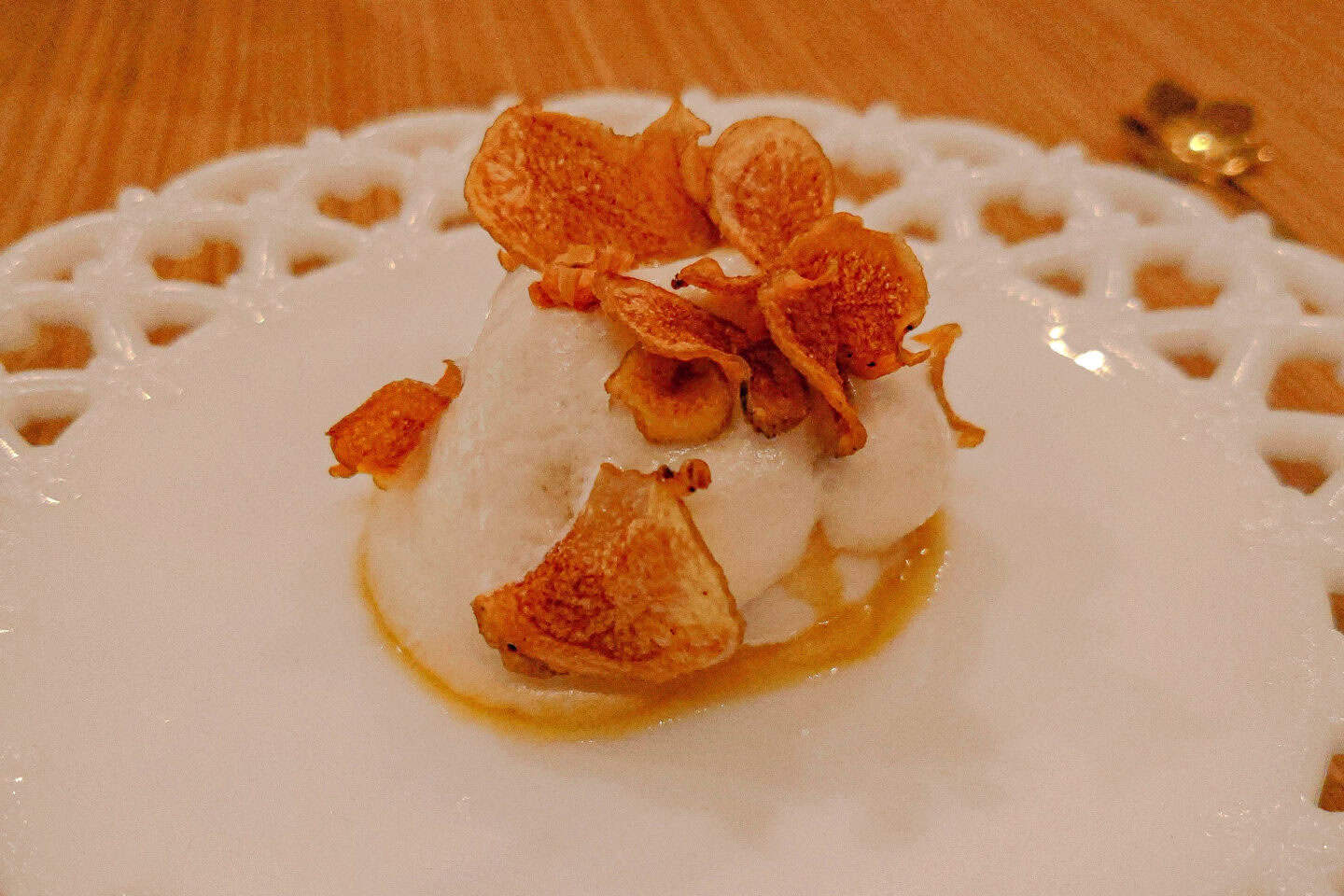
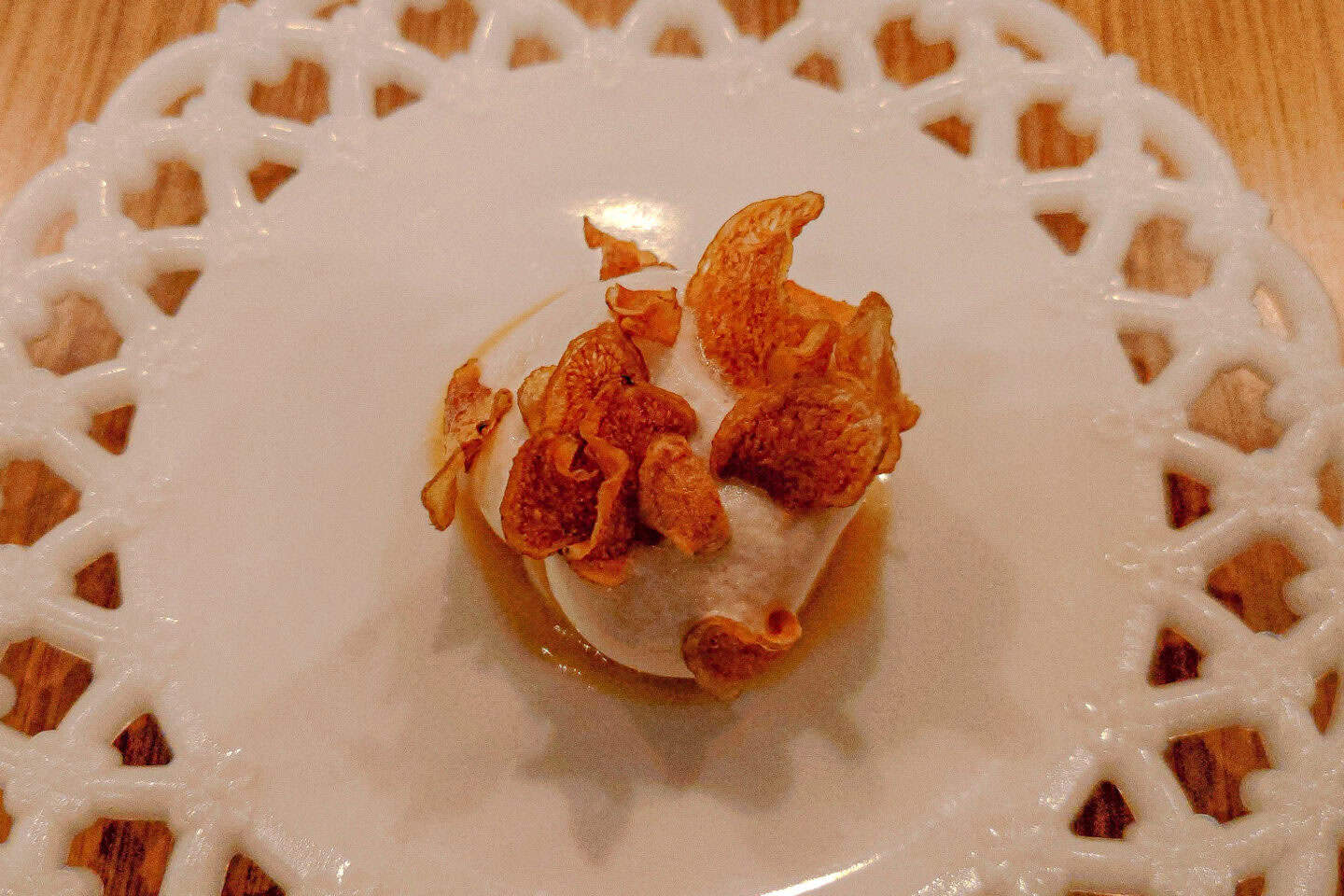
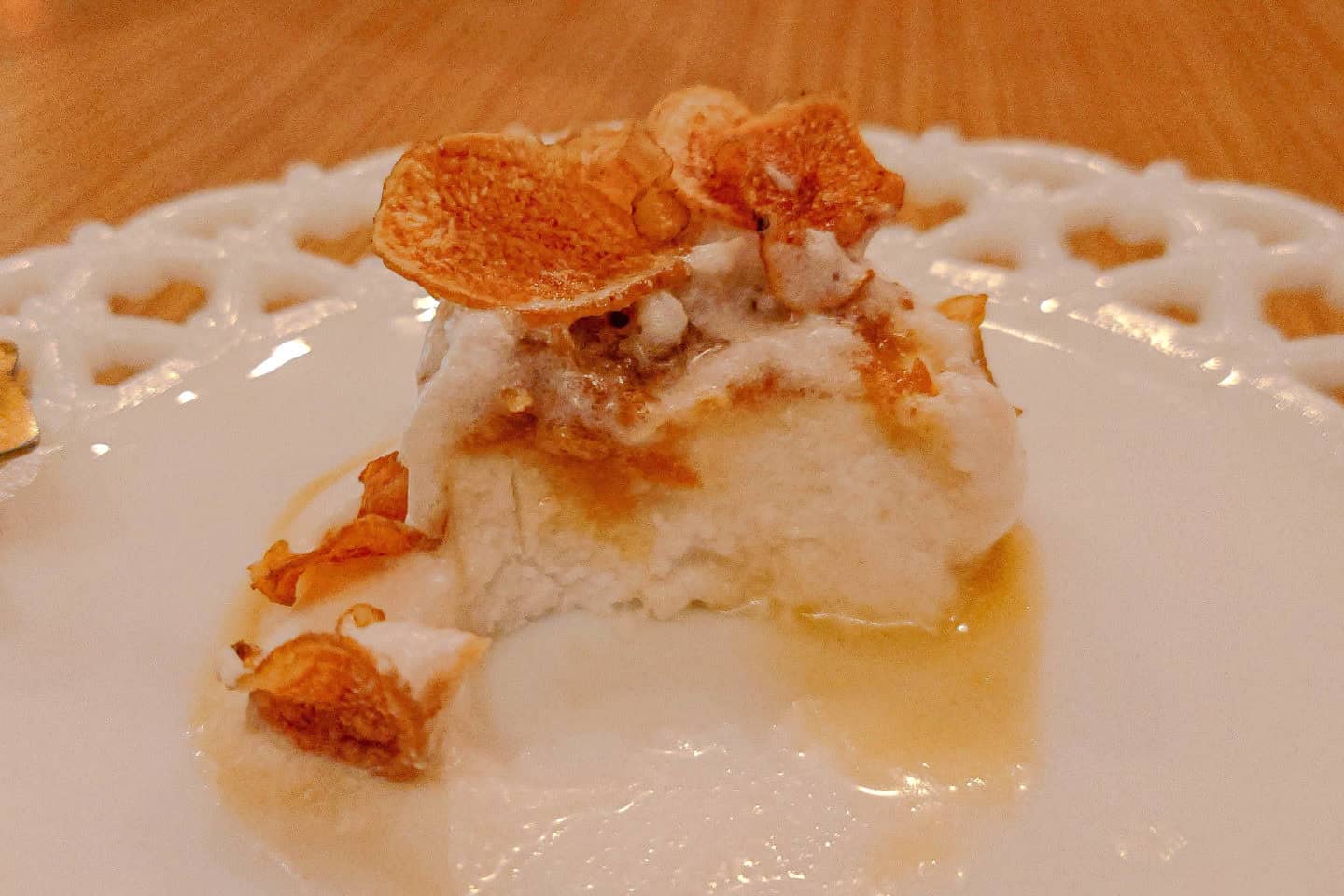
Moving on to desserts, our first dish was a coconut panna cotta. It tasted like a wet pavlova – lots of coconut cream with bits of crunchy smoked fruits (forgot which one) to cut through the bite. The Chef described it as a modern take of Thai dessert but if we ate this without context, it honestly did not remind us of anything Thai. Where’s the durian and mango?. It was our least favourite of the desserts.
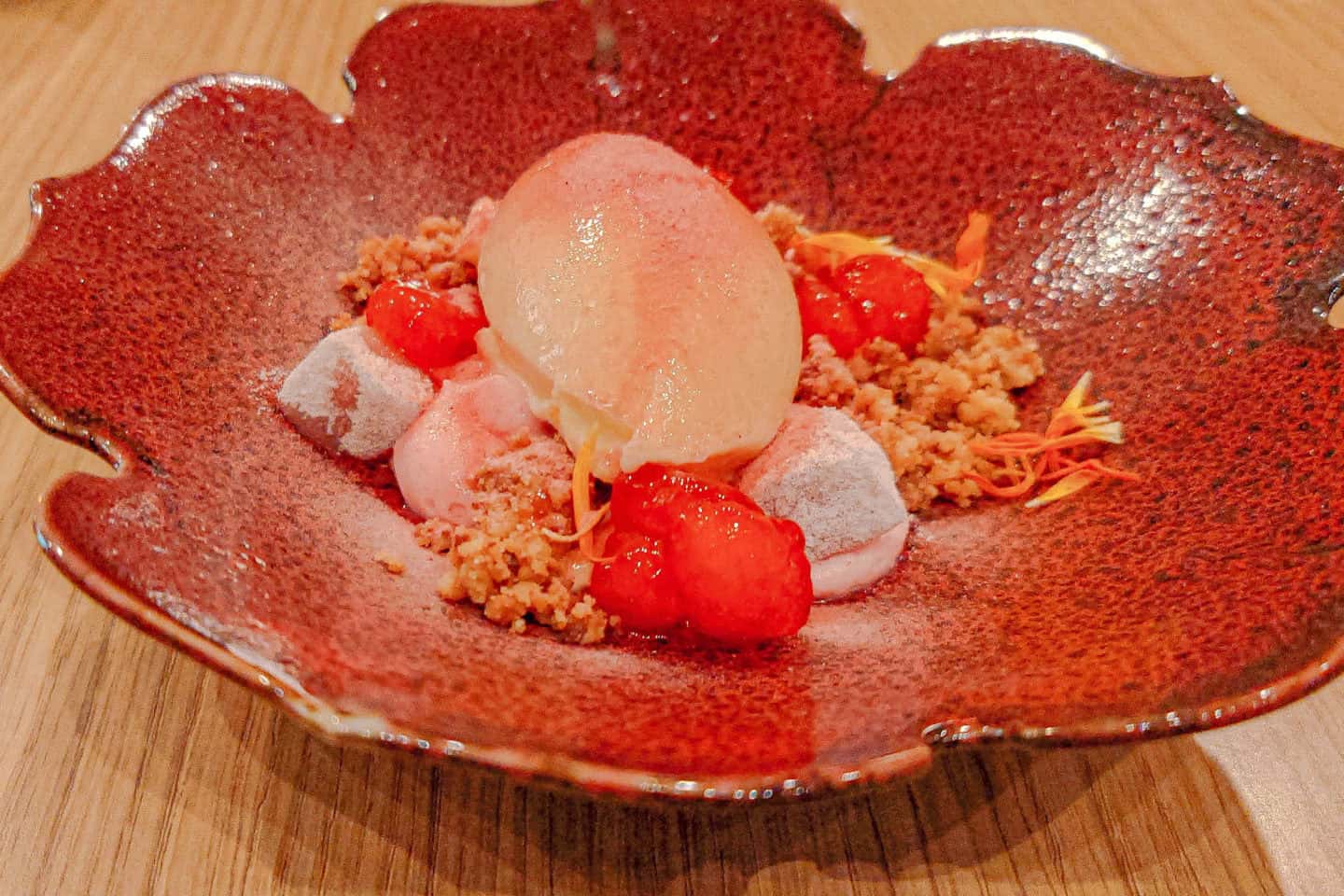
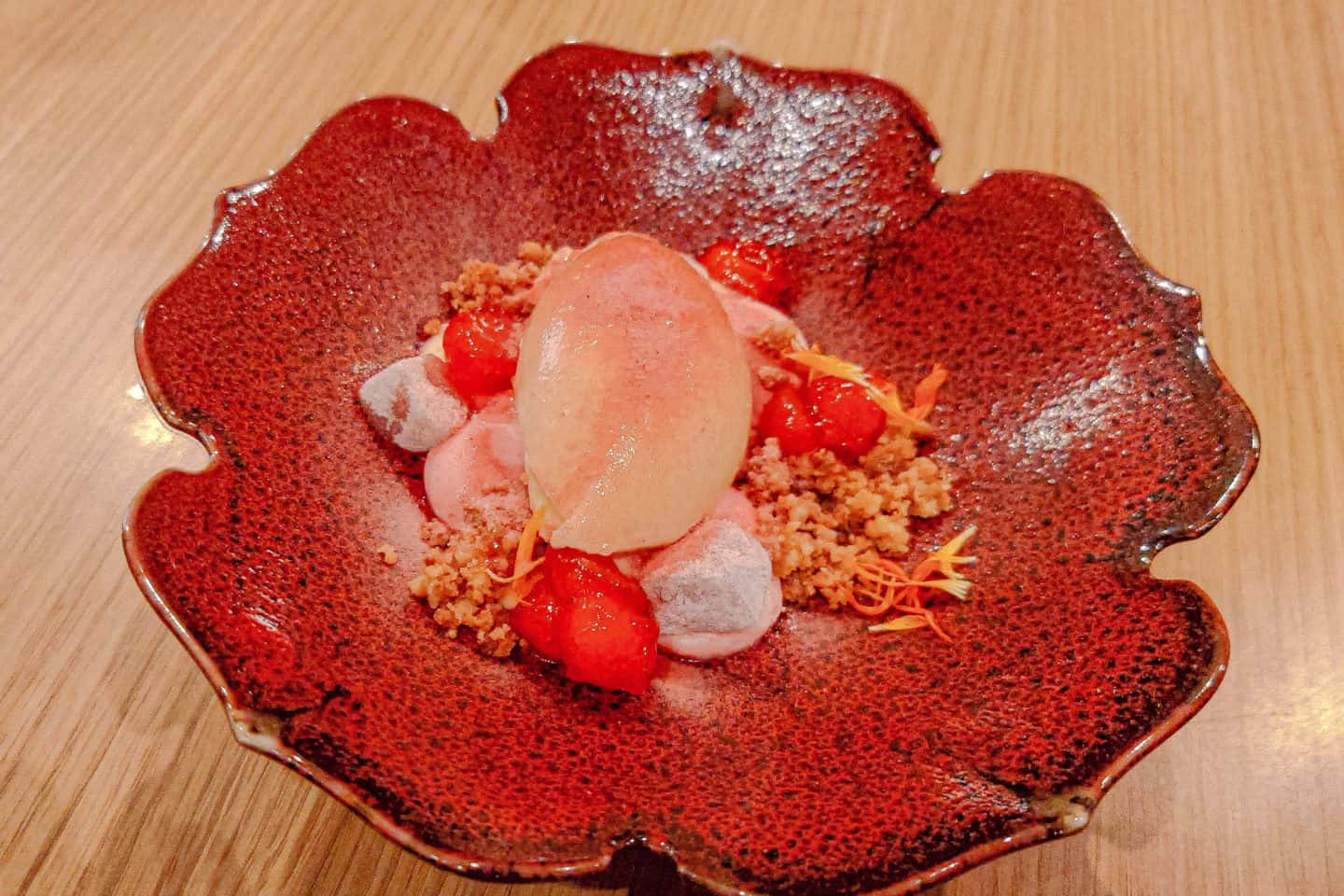
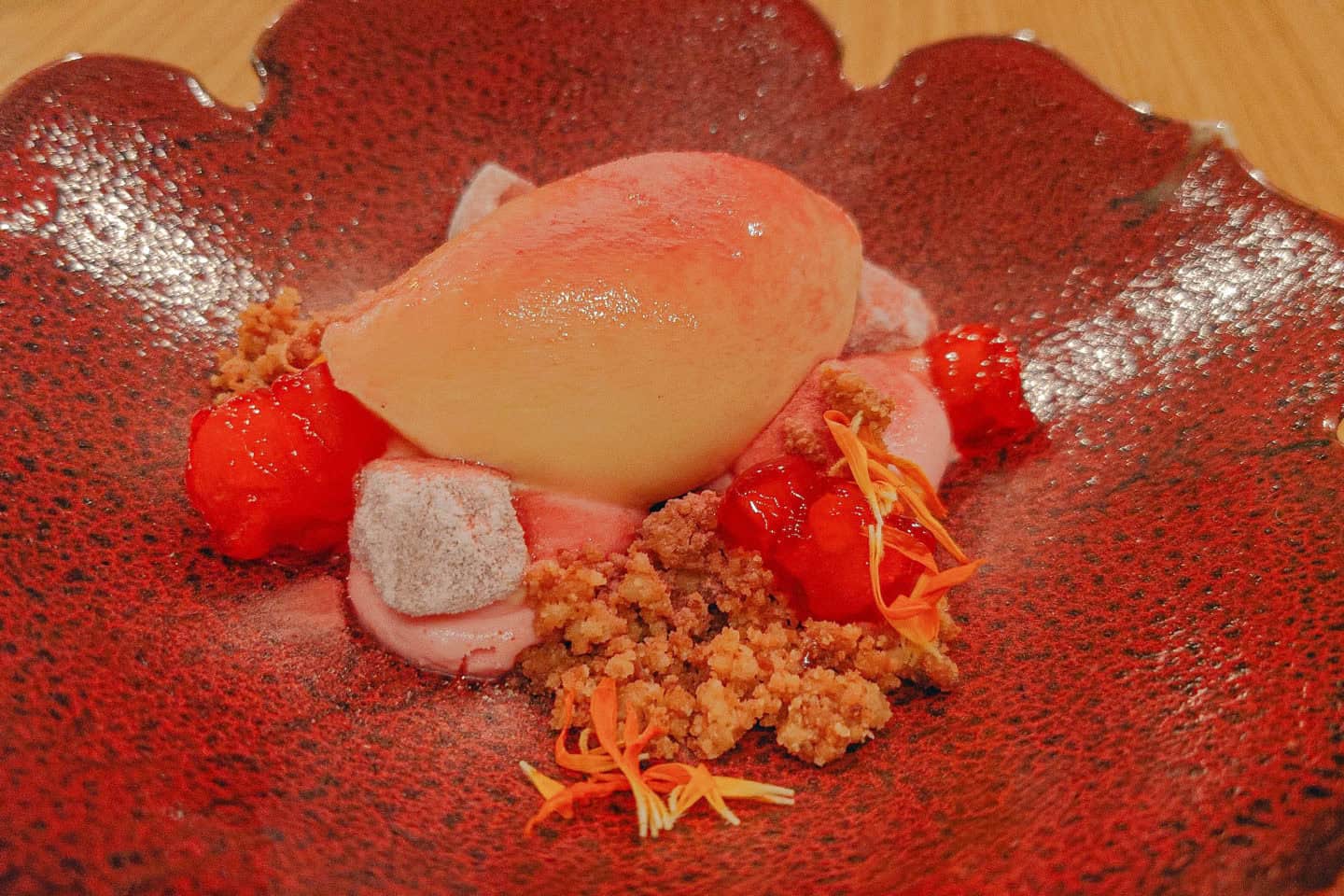
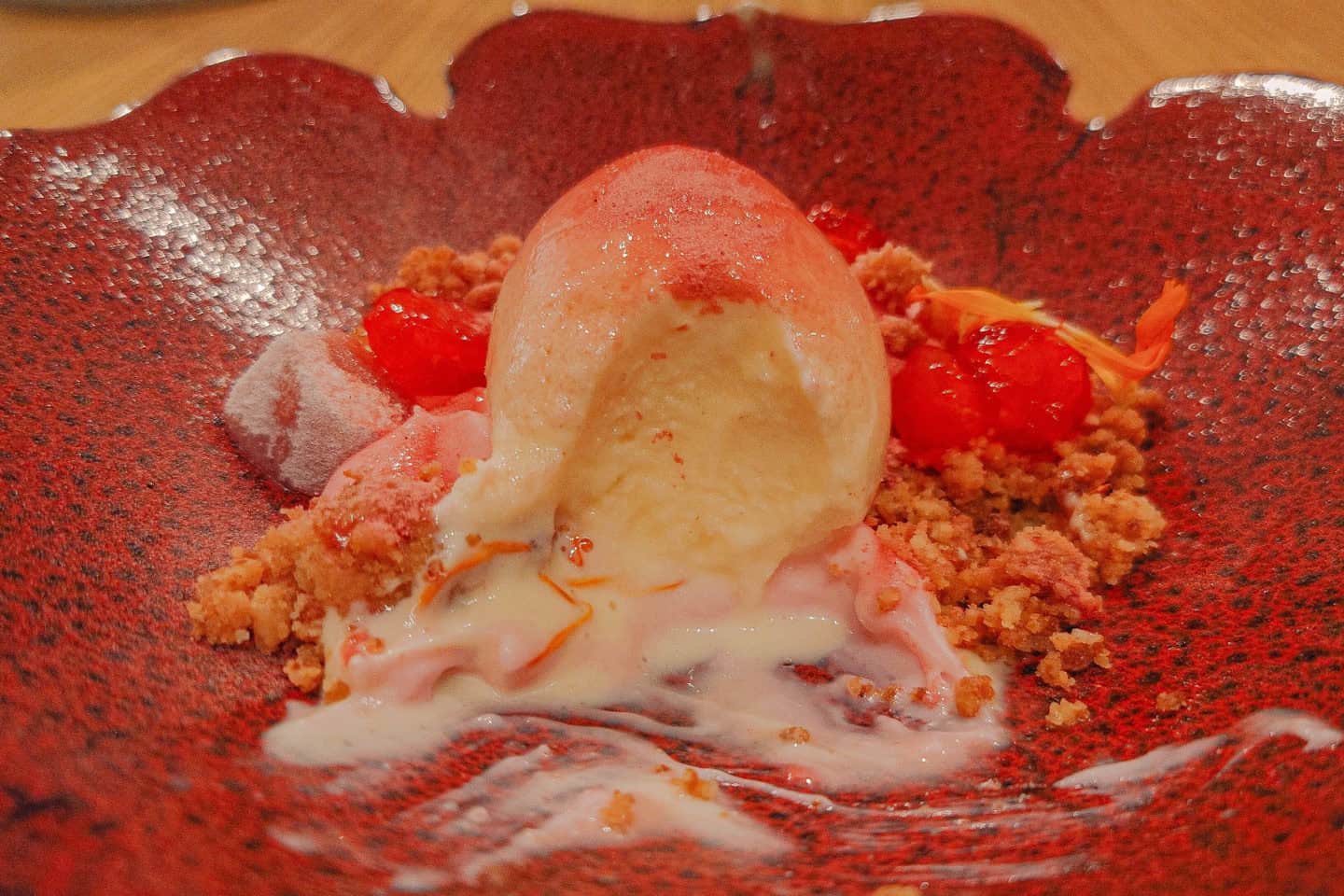
This dessert coconut ice cream was created on a whim with the Chef’s unique creativity. It was Thai-styled strawberry mochi, coconut cream cheese, snake fruit (red item), boiled chestnut, water chestnut and a hint of kumquat. There was a LOT going on with this one but somehow, it worked well. Every bite was refreshing and sweet (but not too sweet – Asian compliment 😂).
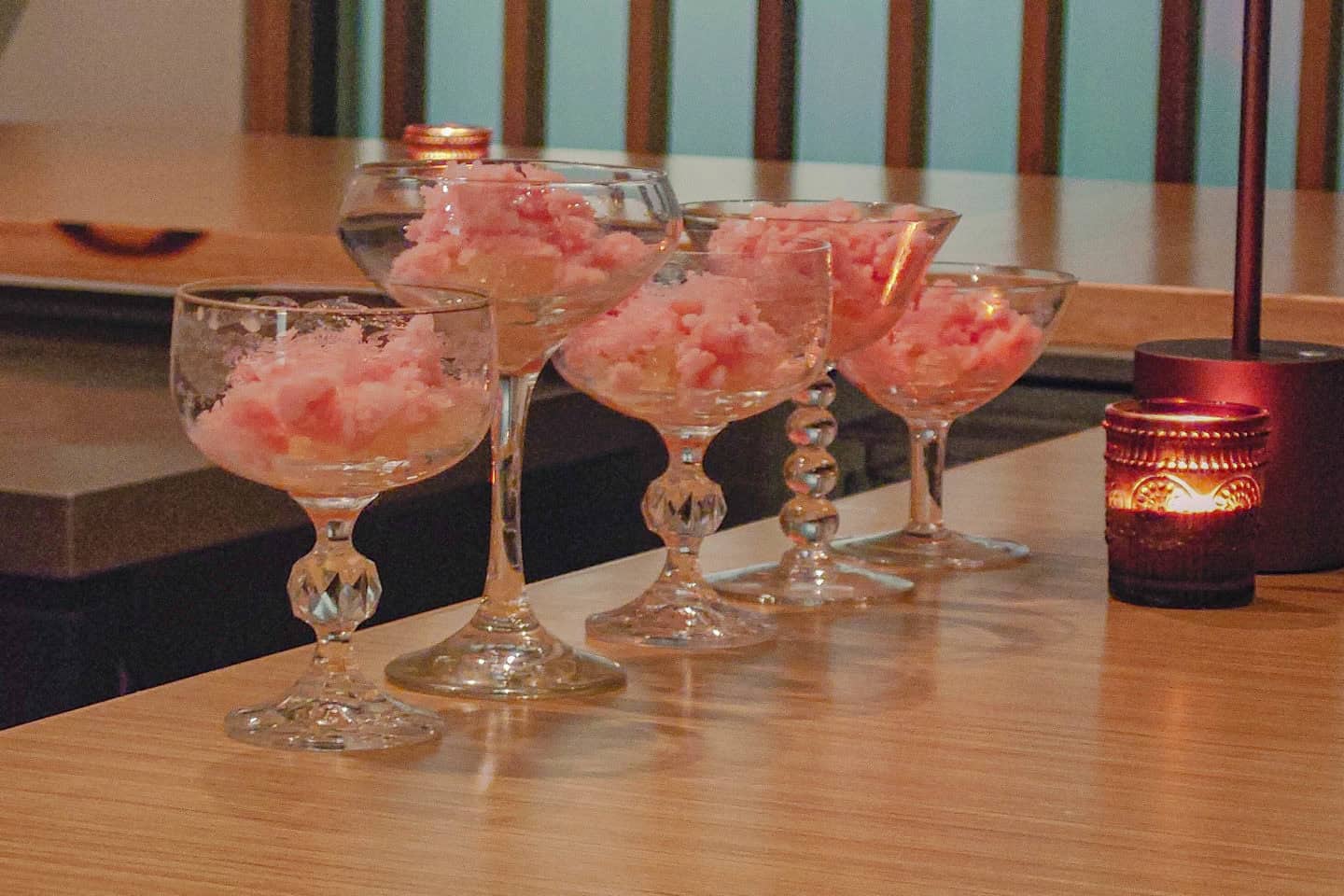
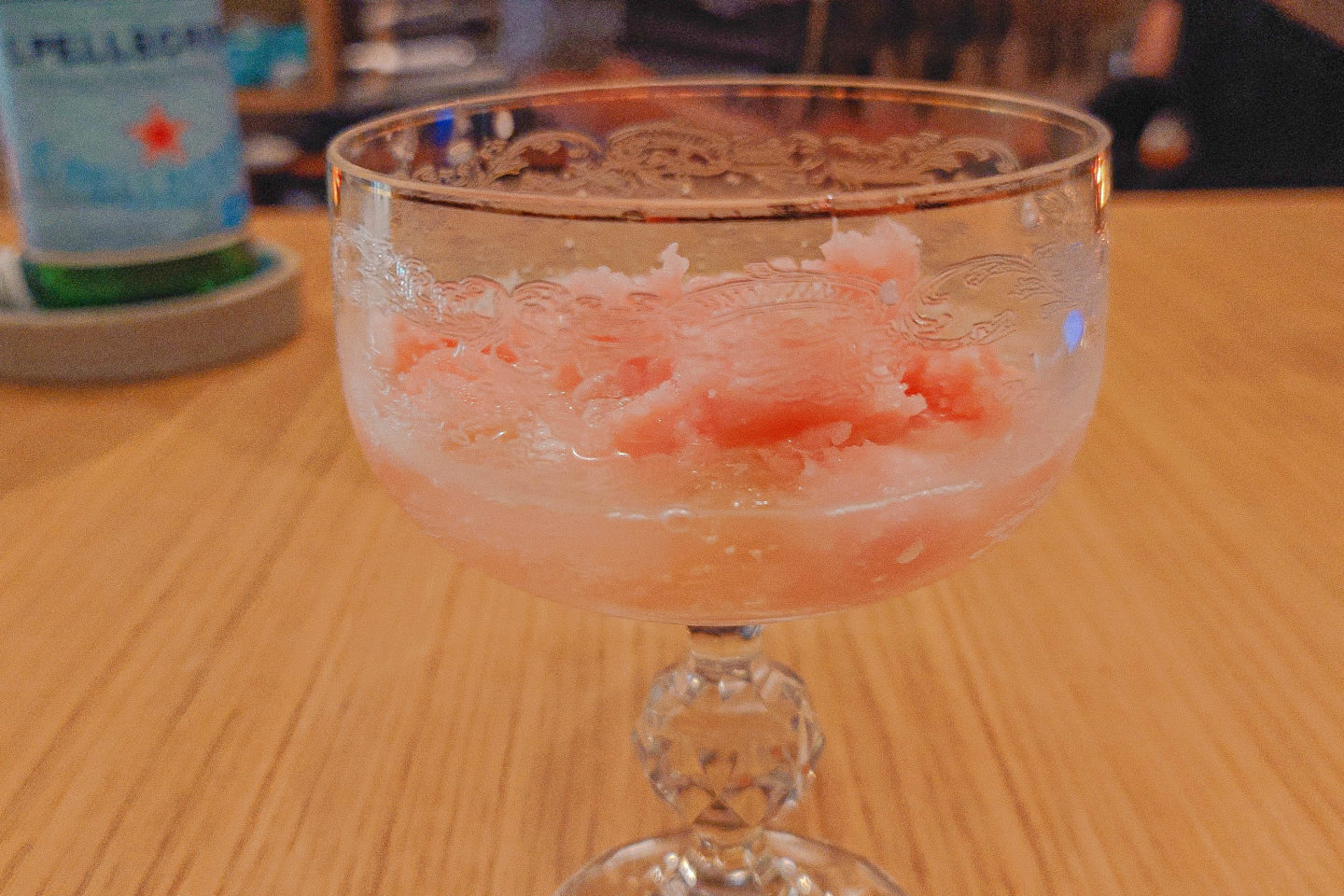
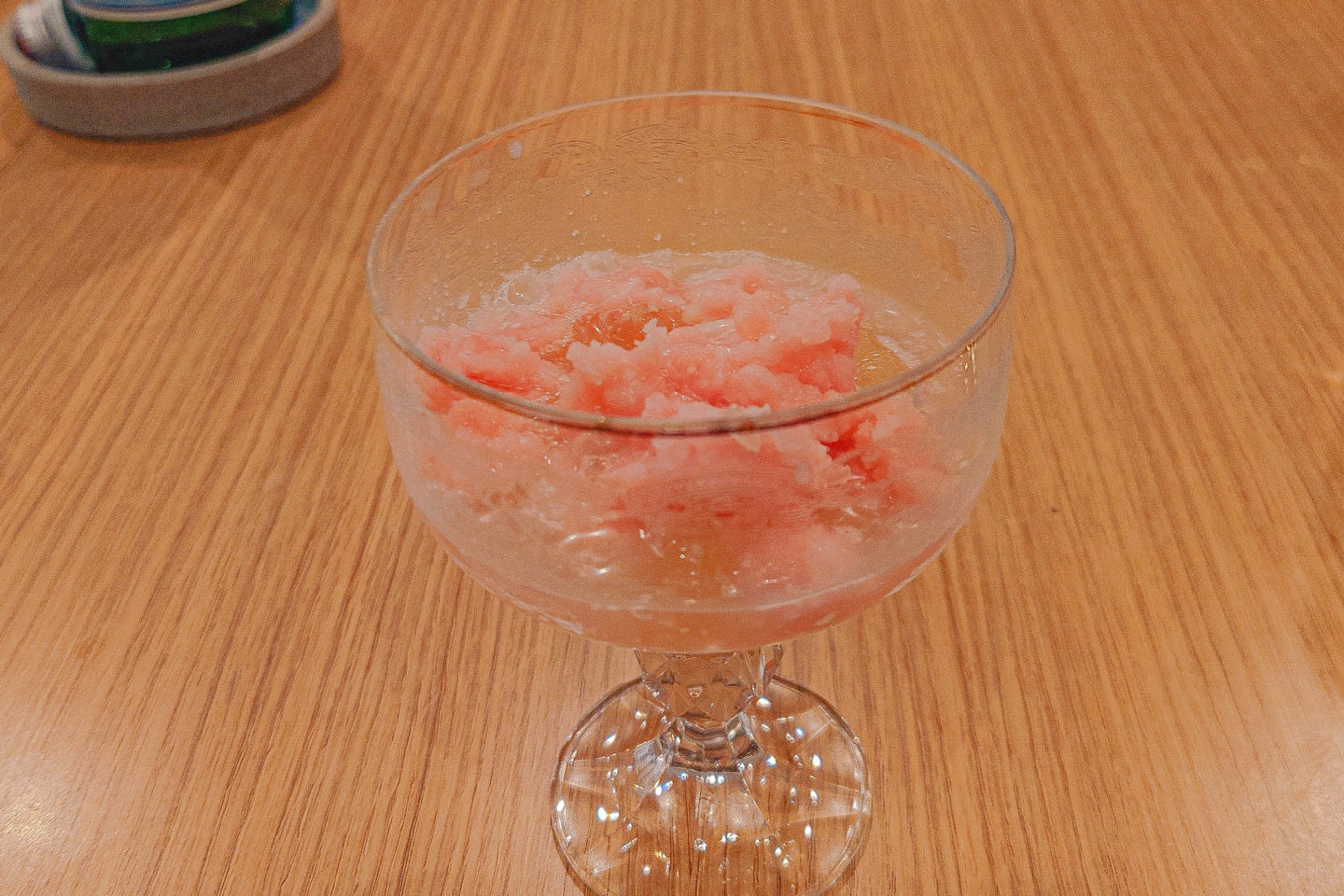
This was an additional palate cleanser with jelly, sorbet, yuzu and champagne. It was enjoyable and light, and an interesting end to the night. However, we feel they only added this to impress the patron (who is also a chef) dining with us – more of this under Service below.
Service
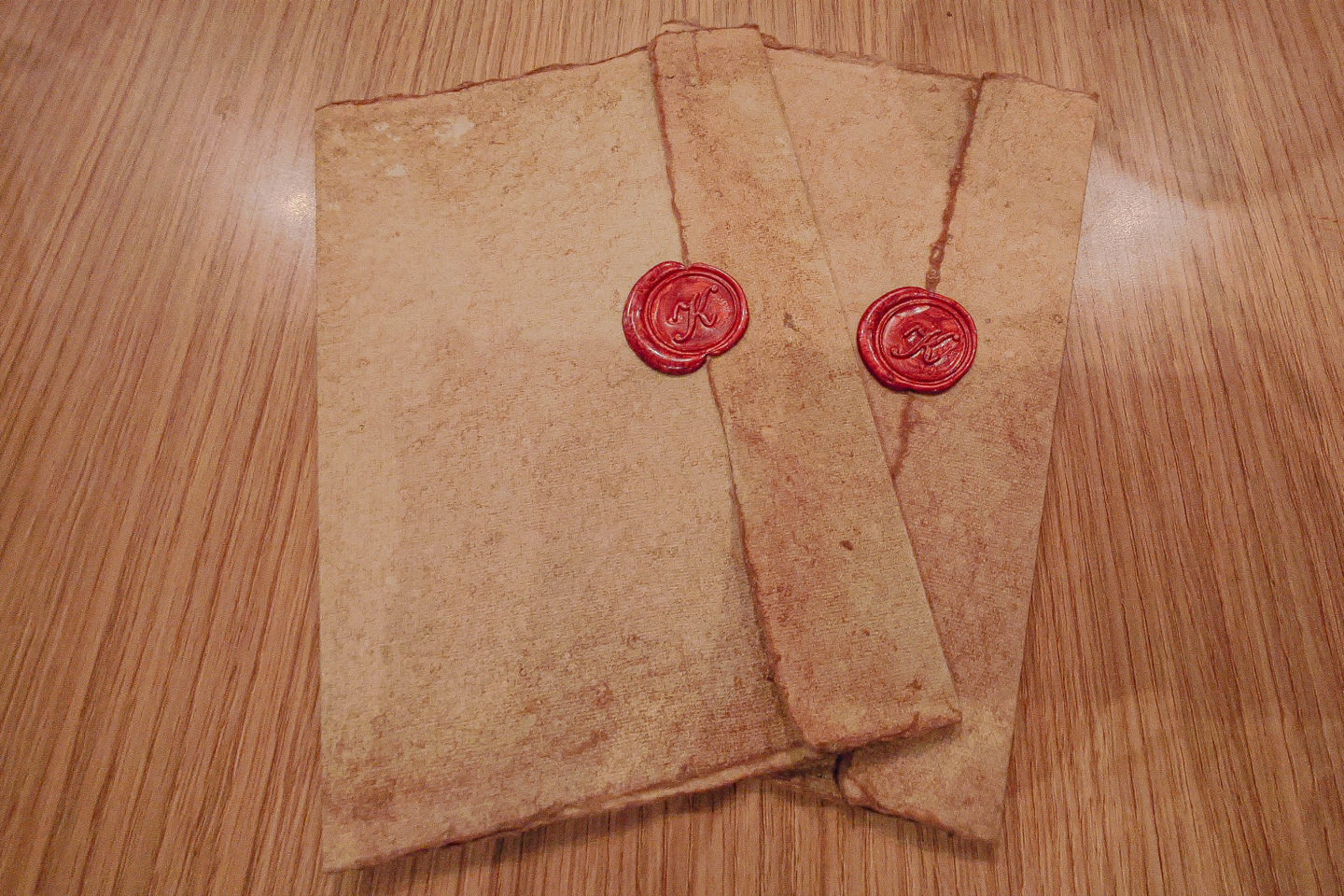
We thought the service for Chef’s Table was all over the place. Like I mentioned earlier, there was a patron dining with us (who was also a chef in a different American city) and the Chef + server of Kinkan LA spent the entire night kissing this guy’s ass.
We tried to start conversations about Viet/Thai food in America and they shut us down really quickly. They also dismissed us when we told them we were from Australia and had a high population of Thai cuisine – and I quote “Who cares. I’m American so I don’t know much about Thai food, I just know we have San Jose“, all the while going back to the Chef Patron and asking him what kind of Viet/Thai food he had in the American city he was from. (Mind you, the Chef is Thai, the server is Viet). It felt so patronising and typical American to not know a single thing about the rest of the world, yet still try to profit off other people’s cultures 🙄🙄🙄.
They were also kind of snobby. We asked them why their menu changed so often, sometimes weekly, because we wanted to try that crab head dish. We thought it was due to supply issues. Their response: “we’re that good at it that we can do what we feel”.
FYI they’ve already changed the menu twice since we dined there a fortnight ago. Overall the dishes were a hit and miss. There was nothing amazing in gastronomy about the food that would make us recommend this or come back.
Also the price was $175 USD, plus an extra $90 USD tax + a forced 20% gratuity. The server added it automatically even though California has no laws for minimum tips. Charging a premium because you think you deserve it when your service was oddly paced and messy is so … arrogant. 🙄 We should have gone to a Michelin star restaurant instead.
To the Kinkan LA staff: If you truly wanted to serve good food, do it right by the food and culture. Don’t slap the label fusion on it hoping to make $$ off uninformed patrons. You’re not going to create a legacy this way. Eat some humble pie. Improve your service and pacing and maybe you’ll earn a Michelin star.
We tried to start conversations about Viet/Thai food in America and they shut us down really quickly. They also dismissed us when we told them we were from Australia and had a high population of Thai cuisine – and I quote “Who cares. I’m American so I don’t know much about Thai food, I just know we have San Jose“, all the while going back to the Chef Patron and asking him what kind of Viet/Thai food he had in the American city he was from. (Mind you, the Chef is Thai, the server is Viet). It felt so patronising and typical American to not know a single thing about the rest of the world, yet still try to profit off other people’s cultures 🙄🙄🙄.
They were also kind of snobby. We asked them why their menu changed so often, sometimes weekly, because we wanted to try that crab head dish. We thought it was due to supply issues. Their response: “we’re that good at it that we can do what we feel”.
FYI they’ve already changed the menu twice since we dined there a fortnight ago. Overall the dishes were a hit and miss. There was nothing amazing in gastronomy about the food that would make us recommend this or come back.
Also the price was $175 USD, plus an extra $90 USD tax + a forced 20% gratuity. The server added it automatically even though California has no laws for minimum tips. Charging a premium because you think you deserve it when your service was oddly paced and messy is so … arrogant. 🙄 We should have gone to a Michelin star restaurant instead.
To the Kinkan LA staff: If you truly wanted to serve good food, do it right by the food and culture. Don’t slap the label fusion on it hoping to make $$ off uninformed patrons. You’re not going to create a legacy this way. Eat some humble pie. Improve your service and pacing and maybe you’ll earn a Michelin star.
Review
We really think Australia is spoiled with good food culture because our standards have made it difficult to agree to American foodies and their tastebuds. Most of the reviews for Kinkan La was to flex 🙄 so it’s no surprise this dinner was an overhype and a waste of money.
Don’t go to Kinkan LA. You will regret it.
Thanks for reading. Happy eating!
P.s. The only reason I felt full was because I had 5 meals that day (3 taco trucks, Pop Eyes, Chick-fil-A).
Don’t go to Kinkan LA. You will regret it.
Thanks for reading. Happy eating!
P.s. The only reason I felt full was because I had 5 meals that day (3 taco trucks, Pop Eyes, Chick-fil-A).
